Read the blog
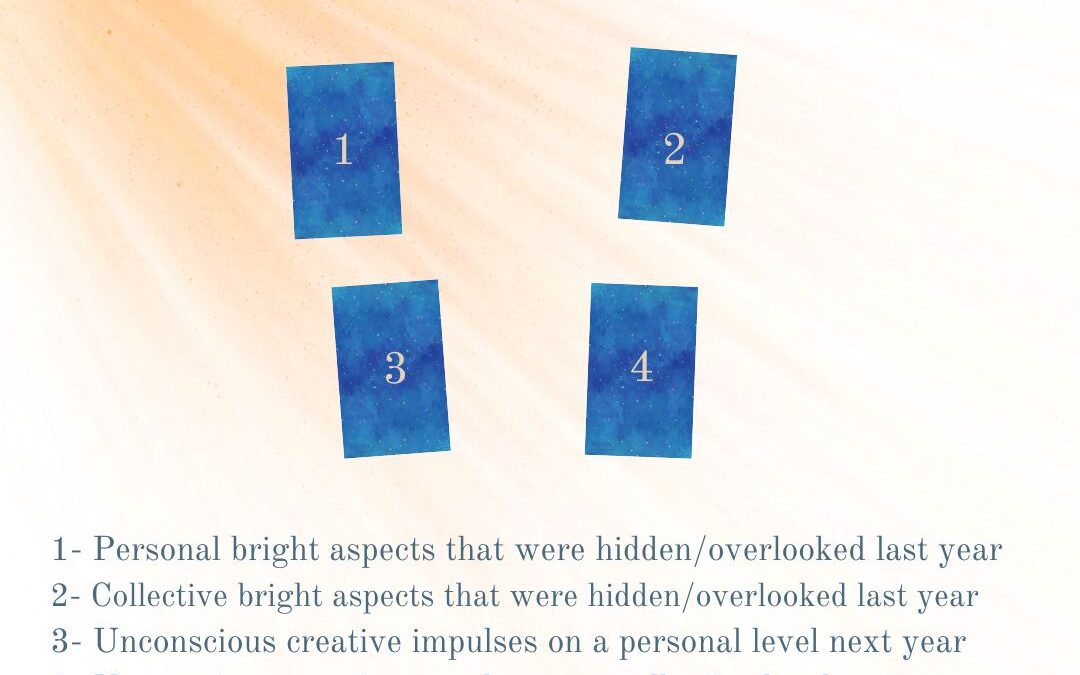
The golden shadow
I just finished reading Tarot Celebrations by Geraldine Amaral & Nancy Brady Cunningham, which caught my eye because it approaches tarot with a Jungian perspective. It’s a decent intro to psychoanalyst Carl Jung and how his ideas can apply to a tarot practice. I can’t say much in this book was super in-depth or revelatory to me, but I’m already fairly versed in this subject matter. If you’re new to Jungian concepts and how they relate to tarot I would actually recommend this over many other books.
One particular concept mentioned in the book really hooked my imagination and won’t let go: the golden shadow. The authors say: “this (is) Jung’s concept that the dark shadow has an equal counterpart: the bright or golden shadow which contains your highest potentials and abilities, the inner aspect of yourself which is your best and brightest aspects (which) may not yet manifest themselves in your life.”
My first reaction was, well yeah, I’ve been pointing out something similar for years and I’m glad to see someone else mention it! I gave a talk at a tarot conference a few years ago where I referenced a lot of Jungian concepts including shadow work. I stressed the fact that the shadow is not just scary darkness, we also tend to repress many qualities that could be magnificent. I didn’t use the phrase golden shadow because I’d hadn’t heard it yet, but I was getting at a similar sentiment and something I think is often overlooked in shadow work.
Shadow work is quite popular among tarot readers (shout out to Kelly-Ann Maddox who has taught on this topic for many years) so you’re likely familiar with the concept but in case not: the shadow, according to Carl Jung, consists of the aspects of your consciousness you repress, deny, or project onto others. Shadow work is a broad term that encompasses any number of methods for bringing the contents of your shadow into your conscious mind (such as journaling, therapy, pulling tarot cards etc). The idea is that you find a greater experience of wholeness by integrating the shadowy unconscious into the totality of your Self.
A lot of shadow work modalities focus on aspects of the shadow that are tricky. Which is kind of part of the package: acknowledging what is shameful or hurtful is a core part of shadow work. But, your shadow is not JUST darkness.
If it has been believed hitherto that the human shadow was the source of evil, it can now be ascertained on closer investigation that … (the) shadow does not consist only of morally reprehensible tendencies, but also displays a number of good qualities, such as normal instincts, appropriate reactions, realistic insights & creative impulses. -Carl Jung
Now, I will say that although I was familiar with these ideas I had never heard the term golden shadow until Amaral & Cunningham mentioned it. Upon some light Googling it seems like this is not, in fact, a phrase Jung himself actually used. One poster on a Jungian forum went so far as to call it an “unnecessary neo-Jungian invention”. Which, okay. But I still like it, and even if the phrase golden shadow itself is not of the Jungian canon, the general concept does seem supported by his work so I’m gonna roll with it.
Here we are on the cusp of 2023 unfolding into 2024. Any time is a good time to do some golden shadow excavation, but it feels particularly appropriate for this moment. If you’ve been following my writing lately, you may have noticed 2023 sucked ass for me. I feel awkward always vaguely alluding to this, but it’s not in anyone’s best interest for me to talk in more depth about it right now…suffice it to say, two of the worst situations of my entire life both erupted in 2023.
And if you’ve been existing as a human being with eyes and ears and heart you may know 2023 was extremely violent on a collective level as well. It was a shadowy, shadowy year indeed. A year that forced a lot of us into some devastating shadow work both personally + collectively (the collective shadow is something Jung wrote about as well). And that difficult shadow work is ongoing.
In the past I’ve offered elaborate spreads and in-depth workbooks for the New Year (anyone remember those?!). I come bearing something simple this year, but I hope it will hold you in feeling into your golden shadows. Because sometimes the tough shit seems all encompassing, we need to make a conscious effort to polish the hidden treasures as well. The contents of the golden shadow may currently be warped and buried; let’s begin to excavate and reshape them with tarot as our guide.

I have the Six of Wands to suggest bright aspects of my own personal self that were potentially overlooked or unconscious during 2023. Many people say the Six of Wands is about triumph, but Resiliency is the word that comes to mind here today. And it makes sense as I’ve never believed myself to be incredibly resilient. If you would have told me half the shit that was gonna happen in 2023 I would have said “wow, I’m going to crumple up and hide in a corner.” And I mean, sure, I’ve done that a time or two. But I’ve also had moments where I managed to sit down, like the person on the card, re-steady myself and tend to inner fires. That resiliency, once unseen, is something I’ve already started to acknowledge. This card encourages me to continue that process.
Here is our old friend the Eight of Cups who also showed up in the last spread I shared. This time it speaks to bright aspects on a collective level that may have been obscured or unacknowledged during 2023. Last time I used a phrase for this card which very much feels applicable again: new ways of being are always revealing themselves to you. Perhaps we haven’t yet grasped the final form of the new ways of being which began to reveal themselves during 2023. And that’s okay. After all, the end of a year is an arbitrary thing. Our lessons and revelations rarely fit tidily within a calendar year.
Perhaps right now even if we can’t fully understand the new ways of being 2023 drew forward, we can at least look for the small glimmers, and like the woman on the card, embrace the metaphoric moons as they continue to move into fullness.
Now we look at 2024, with the Emperor representing my own personal creative impulses, which may be unconscious, that perhaps I can integrate this year. This made me laugh because I have a narrative about myself that I am ~*ChAoTiC*~. But the Emperor, of course, brings chaos into order. Perhaps during 2024 I can look for fresh opportunities to do just that. In a way, it’s a continuation of a journey I’ve already been on. You know, I titled the first post I ever made on Substack “Chaotic ramblings” on a book. When in reality, it was a pretty well organized and thorough book review. The Emperor asks me to take greater credit for my ability to be structured, and to affirm that this type of order can actually create space for greater creativity.
The Three of Pentacles is such a wonderful card to complete this reading, representing unconscious creative impulses available to us on a collective level this coming year. I… actually can’t imagine a more perfect card here? People working together, but each in their own way, bringing their own talents and strengths into the fold. It’s such a delicious counter-narrative to the stories of cutthroat competition and winner-takes-all mentality which still permeate much of humanity. But it doesn’t have to be that way. How can we unearth the collaborative aspects of human nature this year and beyond? Many of us have already been asking this question, and perhaps 2024 broadens the depth and scope of our understanding.
So there we are! Another year in the books. Another on the horizon. Wishing you well truly, and I’m grateful you’re here.
Carrie
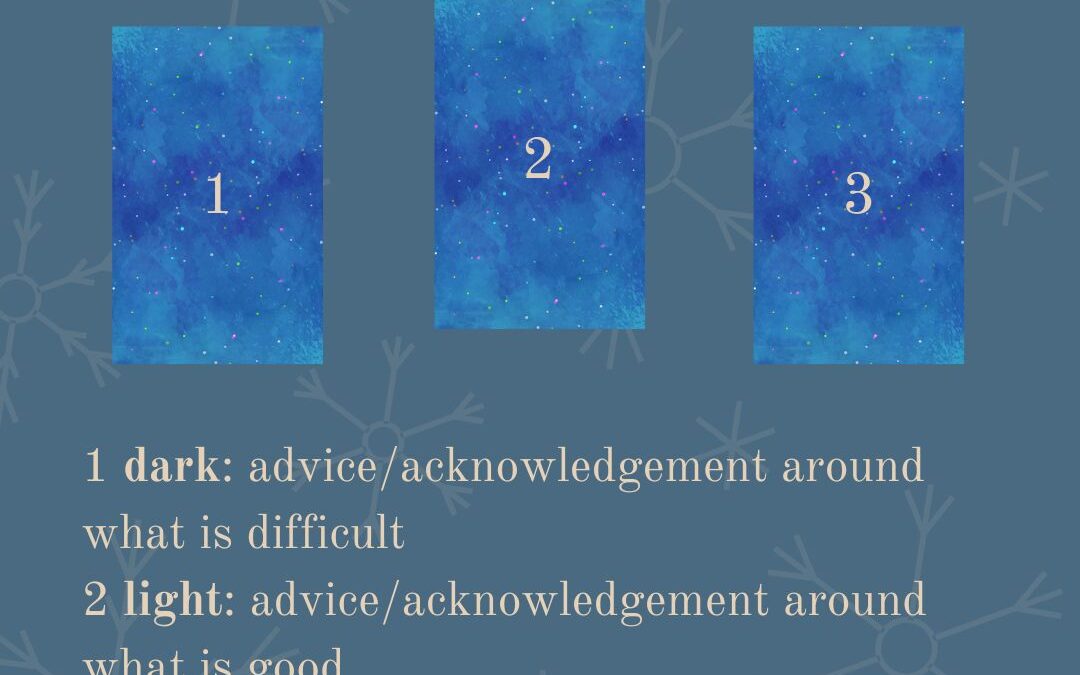
dark, light, gift: a winter solstice spread
The framework for a simple tarot spread came to me in the shower today (as interesting ideas often do). It’s a day late but this is somewhat solstice themed, and also more broadly winter themed. In the past I’ve been known to take on longer, more complex spreads for the solstice. But this year simplicity feels right. As I’ve been doing lately, I’ll pull some cards for myself and offer them up if they happen to ring true to you. Perhaps after that you’d like to try the spread for yourself?
Oh and also: I support rebellion, so if you’re in the southern hemisphere or stumble upon this post at a different time of year, perhaps you might still partake.
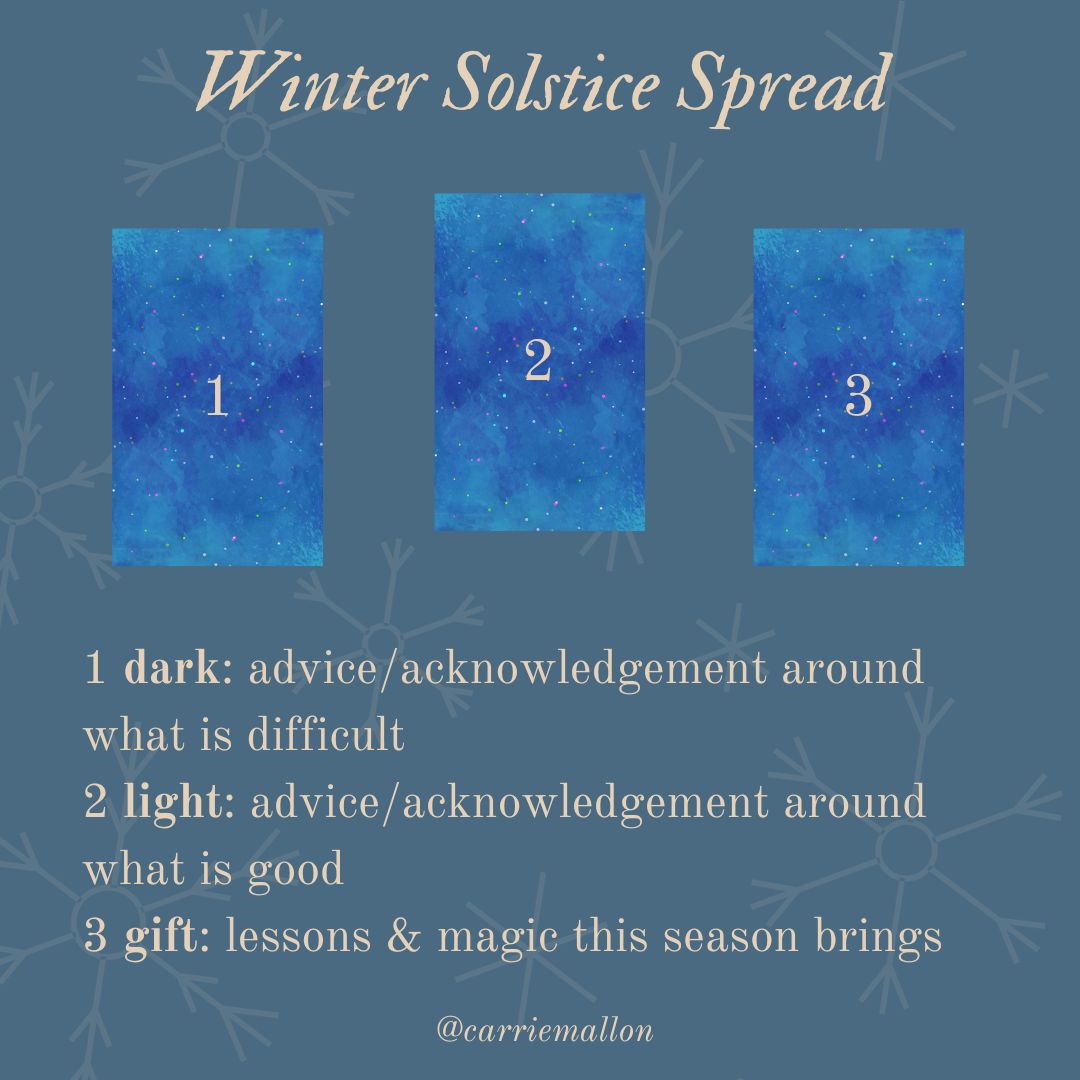
First, in the dark position, we have the Four of Swords. This…makes so much sense to me. What is difficult right now? Getting my thoughts in order. Maybe you can relate? It’s partly the season: getting and wrapping gifts, planning meals, winding down the year, making lists and checking them twice.
In a broader view, it’s difficult to make sense of the entire damn world right now. Four is a number of structure, swords are the mental realm. So the Four of Swords can be about understanding. The ability to explain something clearly. That moment when everything clicks into place and you have a clear picture.
That’s not my experience of observing the world right now, though. Things seem extra violent and dark. As much as I crave a clear understanding, it isn’t there. Many things do not make sense. There is no solid theories to explain the way things are.
But even though this is the ‘dark’ position, in a way I think this is a good thing too. Sometimes the most powerful thing you can do is say “this doesn’t make sense, I don’t understand this, and I’m never going to.” Our human minds like to have rationalizations for everything. Going against that urge to rationalize something that truly cannot be rationalized is difficult but at times necessary.
For light, we have the Eight of Cups. This phrase comes to me:
new ways of being are always revealing themselves to you.
I certainly believe this. In fact, this is an undercurrent that is always present in my tarot practice. Tarot itself is always new. You see the same cards but always revealed in a new context: a specific spread position, next to a contrasting card, in a different deck. You see the same cards but in one instance you are more drawn to a color, or a particular aspect of the composition, or a subtle symbol you’d overlooked previously. Tarot is always new, and it is always revealing new ways of being.
This card is very welcome, especially after the more rigid messages of the Four of Swords. The imagery for this card is still dark, but the crescent moon winks at the new ways of being that are always emerging. At the same time old ways of being fade away. Something is always concealed. And lately, I think I’ve been directing too much energy towards what is concealed. Because at the same time, something is always revealed.
So what exactly is this light? What precisely is this new way of being that is revealing itself? I WANT TO KNOW. I want to define it (Four of Swords energy still at play, am I right). But the Eight of Cups now feels less about identifying a new way of being in a definitive way, and more about being open to how this organically flows. This isn’t something else that can be added to the to-do list we mentioned earlier. It is something that only comes from openness and presence and feeling into what draws you.
In the gift position I have reversed Five of Pentacles. My lord. I believe the gift here is: you don’t have to carry everything alone. None of us do. The imagery for this card shows a lone wolf with an injured leg scaling a muddy hill. But there is support visible on the horizon. In this moment it occurs to me that the wolf is close enough to make some noise and be like “HEY! You up there. I need help.” And maybe that help is just waiting to be summoned.
In the ‘dominant culture’ we still encounter a lot of messages of ‘rugged individualism’. Like, life is hard but just pull yourself up by your bootstraps and you’ll make it through! Even those of us who have done some work to dismantle these messages can still sometimes have moments of shame that we aren’t able to keep pushing up that hill. So maybe the gift is the willingness to shout out: “this sucks and I need help.” Let someone listen. Let the support come to you. Hell, demand the support come to you if you have to.
And the reversal of the card makes me think the gift goes both ways. Isn’t the Christmas season, in theory, supposed to be about helping those in need? So if you’re the one who HAS the resources to offer, do that. If you know someone is struggling don’t wait for them to ask. Choose something specific and give it. I cannot recall where I came upon this advice, but the idea is that when someone is in dire straits it can be difficult for them to form a request. So instead of something open ended like “how can I help,” specificity is key (“I’ll bring a pot of soup Wednesday” or “I’ll make tea and sit with you for an hour tomorrow”).
Did that sound too lecture-y? I do not enjoy sounding like I’m giving a lecture when I’m reading tarot, but sometimes it comes across that way. Phew.
So there we have it. De-centering the urge for rationalization. Feeling into new ways of being as they take shape and form. Asking for and offering support. A few messages to carry into the season. They are useful for me and I hope they may be of value to you as well.
Truly wishing you the best this solstice and beyond, friends.
Carrie
Gratitarot: an old concept & a new spread
Many moons ago (probably like 2015?) I hosted a community event on Instagram based on a concept I came up with called Gratitarot. The idea is very simple. Gratitude + tarot = gratitarot. In its purest form, to practice gratitarot you simply draw one card and use it as a prompt to consider something you’re grateful for. I’ve been revisiting that practice this week, maybe partly because we just passed Thanksgiving in the US (say what you will about that holiday, but I’m never gonna shit on an opportunity to be grateful).
Gratitarot got a boost in popularity a few years ago when the wonderful Katey Flowers shared it in a video, but I’m sure there are many of you who haven’t yet come across this idea so I wanted to share it a little more in depth with you now. Most notably, I’ve created a new tarot spread I’m going to share and test drive today.
Why practice gratitarot now? Well, this fits the vibe of what I’ve been sharing in general lately, really. I’ve been writing from the heart with tarot and asking tarot to take me home and generally gravitating towards gentle and nurturing ways to connect with my cards. That’s where I’m at these days, and based on the sweet messages I’ve received from some of you, I know I’m not the only one.
I’m sitting here trying to describe how I define gratitude and I still agree with the way I wrote about it in 2020:
Here’s the type of gratitude I’m not about: the type of gratitude that is forced, that is non-specific, that is about bypassing real issues and “just being positive.”
Here’s the type of gratitude I AM ABOUT: the type that is deep, specific, and viscerally felt. Gratitude like this isn’t about forced positivity, but it is about challenging your ego’s tendency to fixate on dumb shit instead of really noticing the magic and beauty everywhere. Gratitude can coexist with a desire for change. Gratitude can coexist with acknowledging what is wrong or painful.
Instead of bypassing the tough stuff, gratitude gives you an anchor into something deeper, something primal and mystical, a force that keeps you afloat amidst the tough stuff. Gratitude is about noticing all of the tiny miracles that surround you in each moment and amplifying them.
As I already said, if you are craving exquisite simplicity, shuffle your cards and pull just one. Use that to describe in as much detail as you can muster something you’re grateful for. When you’re ready to expand this practice, here is the new spread I’ve crafted:
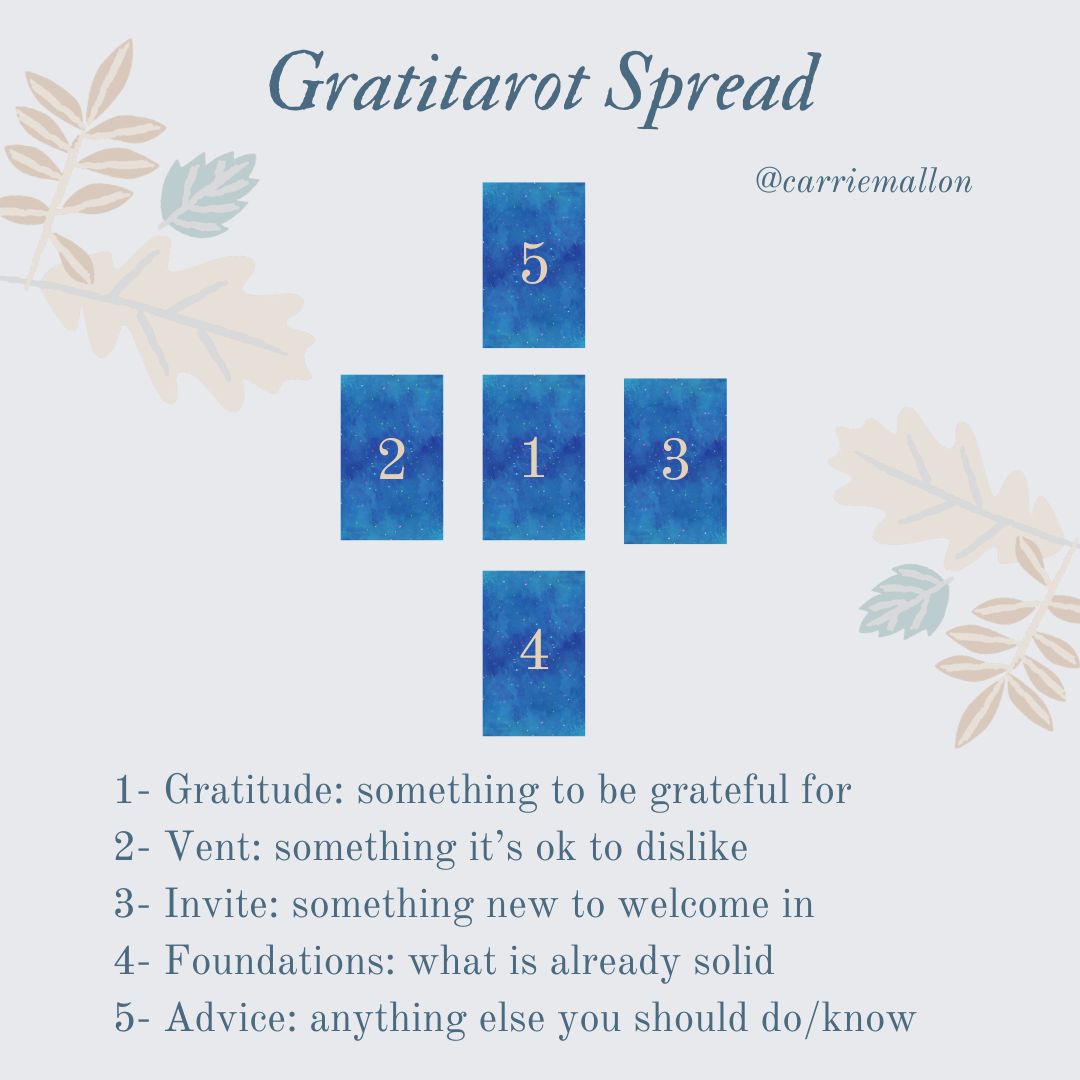
Let’s give it a whirl. As usual, I’m pulling cards for myself but offering messages that may resonate for you as well. I’m using the Pastel Waite-Smith Tarot.
As I was about to lay out the first card my chonky ginger cat, The Squash, came sashaying over, flitting his tail in my face and asking for attention. I reached around him to look at the card and it was the Knight of Wands. Now I’ve never considered giving my cat a tarot significator but this is too much of a synchronicity to be ignored. I mean, look at his tail and the plume on the knight’s cap. They’re practically twins.
I was expecting something more profound, but is this card reminding me to be grateful for my cat? Hmm. On second thought, what is more profound than that? The bond we share with our animal companions is unparalleled. This reminds me that I have a social worker friend who works with suicidal patients. She says that by far the most common reason people give for deciding to continue living is their pets. Imagine that.
I’m lucky enough to have four furry companions and while they do bring an element of chaos into my life (which is also on brand for the Knight of Wands) they also infuse my days with so much enthusiasm and adventure. I am sincerely grateful for them and I appreciate the Knight of Wands and the Squash providing this reminder.
The next position brings some balance in. Even though we are focusing on gratitude, that doesn’t mean we can’t name what sucks. So I have the Magician in the vent position. I recently watched the first episode of White Lotus and there’s a scene where a husband is having a cancer scare and the wife says something like “you’re going to be fine, good things happen to good people.” I’m sure the writers intended this to be a cringey line and it is indeed, and it reminds me of a shadow aspect of the Magician.
Personal power is a theme commonly ascribed to this card. We have the power to create our own reality, or so some people believe. Like attracts like. As above so below. If you put out good energy you manifest good things. And so on. Look, there is some truth to this. But there’s also a whole lotta BS. Sometimes good things do happen to good people. But sometimes bad things happen to good people. And good things happen to bad people. And the things that happen to people don’t always have something to do with them manifesting them. You can’t control everything.
I actually went on a related rant on threads not too long ago where I said “more ‘spiritual’ teachers need to talk about the fact that there are forces in the universe that have nothing to do with you. Not everything is a lesson or message. Not everything is a result of your ‘manifestation.’ You are a component of the universe, not the center of it.”
Next we have the King of Pentacles suggesting something new to invite in. What stands out to me here is how thoroughly devoted the King of Pentacles is to their own realm. There’s a wall behind them, suggesting boundaries. The city in the distance is visible, so it’s not that this King isn’t aware of things beyond their realm. But they are grounded quite contently on their own throne, tending to their little corner of the world.
When I was younger I believed that I could ~*change the world*~. As I get older and more mature, perhaps the King of Pentacles invites in a more realistic view of my sphere of influence. This doesn’t mean I should ignore situations outside of my domain. Not at all! It’s more about deepening into what is actually and truly mine to hold. It’s about cultivating practicality. Not a cold and distant practicality, but a grounded and embodied practicality.
This ties in perfectly with one of my joy guidelines, a set of principles I created for myself to live by. One of them is “take the next small step.” That’s what the King of Pentacles does. She lays the groundwork. She listens. She weighs her energy and abilities. And THEN she moves. So I’m inviting in some gratitude for and awareness of the fact that when a small step is taken with intention, it can be more impactful than an urgent sprint.
Next I have the Knight of Cups in the foundations position. So many court cards! The message that immediately came to me with this one is “your heart is in the right place.” That actually… almost made me cry? My heart is in the right place. Sometimes I doubt this. I think this card is here as a wash of comfort and affirmation. It’s as simple as that.
The Two of Swords rounds things out, bringing any other advice that may be beneficial at this time. This is somewhat outside the traditional interpretations for this card, but I believe it is asking me to pay more attention to my dreams. Maybe even analyze them. Because to be honest, I have been having nightmares lately. Once I wake up, I’m kind of like the figure on this card, putting on a blindfold and trying not to think about them.
What if I went beyond that fear? What if I used the powers of my mind (swords) to explore the watery depths (kept at a distance from the person on this card)? What if I trusted myself to find interpretations of my dreams that are useful and liberating? What if instead of being something fearful, I could find gratitude for these dreams? This is possible, the cards remind me.
There we have it. A gratitarot spread. I hope the spread offers you something meaningful should you try it for yourself. You are welcome to comment or email me to let me know (I can’t always reply to every message, but I receive them and they mean a lot to me).
I am grateful to YOU for being here.
See you next time,
Carrie

Tarot, take me home
The Forest of Souls by Rachel Pollack immediately became one of my favorite tarot books when I read it earlier this year. There are so many wonderful gems, my copy is adorned with underlines and notes. Lately I keep thinking about a passage where Rachel describes being in a difficult time and turning to her tarot cards without any particular spread in mind and saying “take me home.”
It’s not entirely dissimilar from Mary K Greer’s method of writing from the heart with tarot that I referenced in my last post. Both of these approaches to tarot are alluring to me as I continue to find that I’m personally in a tender place, and I think it’s safe to say we are collectively in a tender place as well.
An aside: in my last post I mentioned I’d soon be sharing a piece on gender and tarot. And yeah I thought that’d be out by now… would’ve been nice since it is Trans Awareness Week (HAPPY TRANS AWARENESS WEEK!) but it’s turning into a long one which requires research and brain power, and my brain power is in short supply these days. It’ll be done at some point!
Anyway…tarot, take me home. This feels like exactly what I need right now so I’m going to try it and share whatever comes up with you. I’m using the Spacious Tarot. The Four of Swords, Guardian of Wands & The Emperor have arrived in this moment.
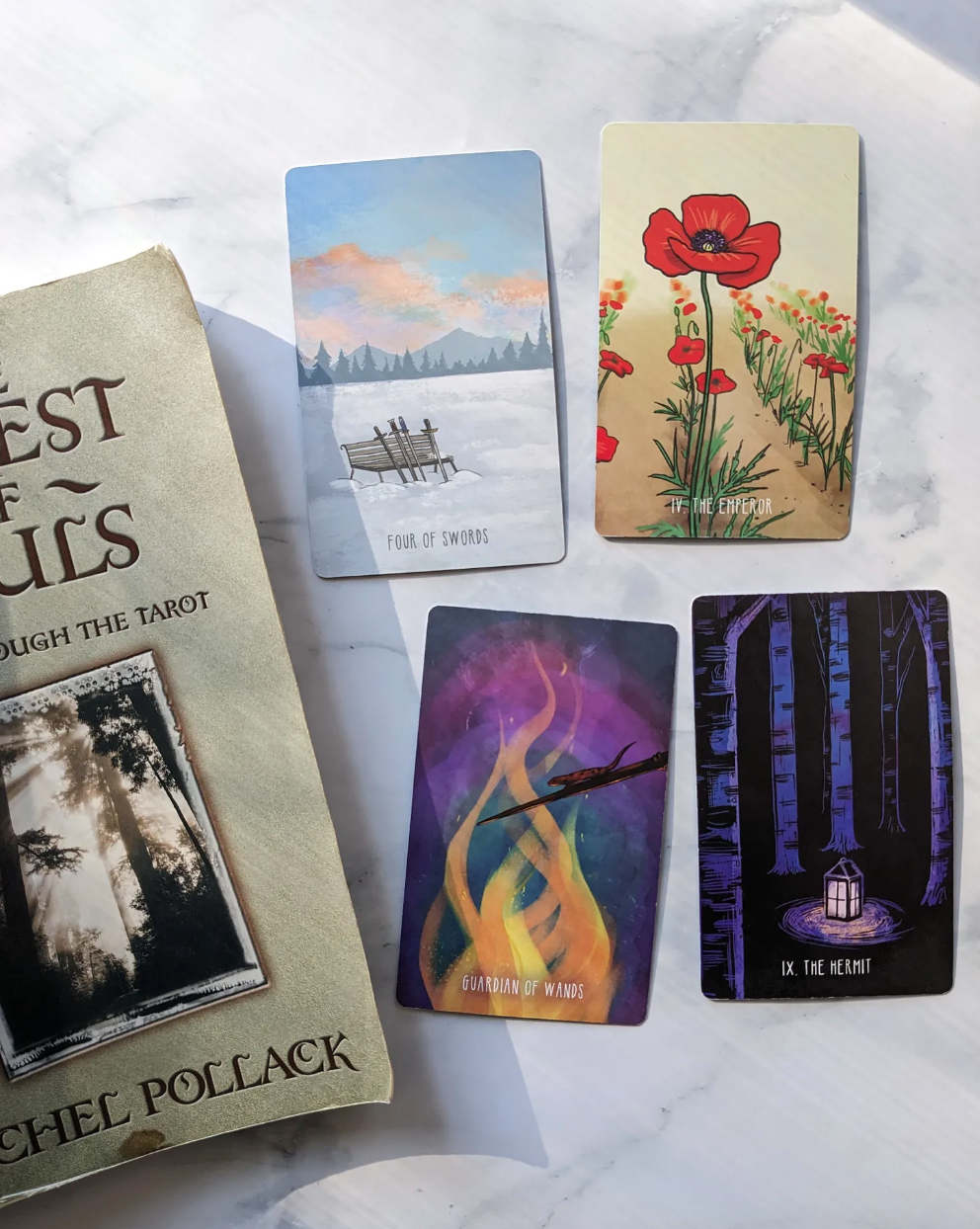
Four is a number of structure, and I have two fours here. So to begin this brings up the question: what is home? More specifically, what is the structure of home that we’re referring to when we ask tarot to bring us home? That is a multifaceted shimmering question as the best questions are.
Obviously, home has a physical level. The four walls you dwell within, the society (or ‘empire’) you belong to, the planet that sustains you. So at the onset perhaps the cards ask: how are you tending to your physical home?
The Guardian of Wands brings this question into greater focus because she tends to a flame, the heart of the home. What is the heart of your home, on all levels, micro and macro? How are you tending to the heart of your home? Where have you been neglectful in your care? What asks for more fuel? There’s a reminder of gratitude here too. At least for me. How lucky am I to have a physical home? I have a semblance of safety. I’m not displaced. That in itself is immense.
There is a vibrancy to the Guardian of Wands and it suggests that tending to your home is not just a chore. It is a joy, or at least it should and could be a joy. What changes does that require? To tend not out of obligation, but out of love? That might mean big shifts in exactly what it is you tend to. Enough caring about dumb bullshit. Time to attune to what actually gives brightness and warmth.
I suppose there is a shadow side to all this too. Because once you move beyond your insulated little home and reach the society level, there’s probably gonna be shit going on that you don’t endorse or agree with but it happens in your name. What do we do with this? It’s different for everyone. Protesting, maybe. Resistance, maybe. Being a radiant, glowing, self-assured example of a different way of being? THAT’S A YES FROM ME.
Sometimes when I look at tarot cards song lyrics randomly come into my head, and looking at these ones I started singing ‘for a minute there I lost myself’ from Radiohead’s Karma Police. All of these cards feel like an invitation to find myself again. What does it mean to come home to yourself? In what ways have I lost myself, and how might I begin to find myself?
I find the Four of Swords is particularly meaningful to these inquiries. We have that stable number four, and swords, the suit of the mind. I am attempting to come back home to my own thoughts, opinions and perspectives. Not in a rigid way. I always want to remain open to other views and new information.
But lately I’ve been entirely too immersed in external ideas: the 24/7 news cycle, the constant bombardment of social media… you know how it is. The noise can be disorienting. I can get concerned I’ll say the wrong thing, or that I don’t know enough, or that someone will misunderstand me (pointless concerns because all of these things will and do happen regardless; they’re part of life and I can survive them). Or worst of all, I get too wrapped up in what everyone tells me I should think to actually…think for myself.
I used to be better about this: journaling, meditating, writing. Articulating my thoughts with care, yes, but not with relentless editing. I’ve strayed from this – for a minute there, I lost myself. Now I want to make intentional space to gather my thoughts like swords on a bench. So that I can take up the space that is mine. Not intrude on someone else’s space, not try to fit into a space I’m actually not suited for. But to assertively inhabit the space that is mine, as the Emperor does at its best.
The interplay of all three of these cards is fascinating in that there is a calmness, but also a boldness. That interplay of calmness and boldness is the energetic space I want to exist within: it is home.
At this point I decided to pull one last card because hey, the number four has been a major theme so adding a fourth card to the mix seems right. And I have the Hermit. A cozy synchronicity that this entire reading is inspired by a book called The Forest of Souls and this Hermit card could be an illustration of such a forest.
Earlier we talked about home as a defined structure in the outer world. The Hermit emphasizes that home is also an internal space. Home is a space within where there is no rush, no expectations, no pretenses. And if you’re into Jungian psychology, home can extend beyond your personal unconscious and into the collective unconscious. In this way, the internal space of home is not isolated. It is solitary, to be sure. But it is still a place of humanity and connection.
The Hermit & The Emperor together remind me of a quote from the poet Novalis: “the seat of the soul is where the inner world and the outer world meet.” I referenced this quote in a post I wrote back in 2018 (which, interestingly, was also about the theme of finding home). At that time I described home as the seat of the soul and that still feels relevant now.
This is an example of how in a broader sense, taking us home is what tarot always does. Tarot is a way for the outer world (the physical cards you lay out) and the inner world (the musings, neuroses and insights the cards evoke) to come together. This is why I always return to the cards. Tarot guides me to the seat of my soul – tarot takes me home.
Sending love always,
Carrie

An unnerving storm
Sharing directly from your heart isn’t always calm, clear and articulate. I want it to be. But sometimes sharing directly from your heart is an unnerving storm.
Mary K Greer has this simple but wonderful method for writing from the heart with tarot. I’ve done it many times and figured I’d do it again today. This wasn’t what I had planned. For my previous two pieces, I took more of an educational angle with an in-depth book review and a discussion on tarot history and the Chariot. I wanted to do something similar today. Teach you something, or share some type of tarot lore.
But I just don’t have it in me right now. Ten minutes ago I was in tears and said to my husband “everything from the biggest issues in the world, wars and genocide and mass shootings, down to the smallest and dumbest minutia of my life, is overwhelming and depressing right now.” It is hard to shift from this into, like… “hey here’s a post on how to read reversed tarot cards!”
Part of writing from your heart with tarot is setting an intention for your writing and today as I shuffled my personal copy of the Spacious Tarot I thought “help me find a message that might be useful to myself and maybe someone who reads this.”
Sometimes when I pull tarot cards they do give answers, help things click into place. Other times, they don’t necessarily illuminate new information but they do something that can be just as vital: they validate what I’m currently thinking/feeling. That’s what the cards are doing today.
The Nine of Wands has me thinking about the theme of protection. Because honestly, I’m not really sure about publishing this post. I think writing more ‘educational’ pieces is a form of protection. Part of why I stopped blogging so frequently is it can feel uncomfortable exposing my innermost thoughts to the world. It feels safer, more protected, to be in teacher mode.
Then it has me thinking about protection as a broader theme. Like how the pretense of protecting yourself/your nation can be used as a justification for unimaginable violence.
Next I pulled the Explorer of Swords. It’s me, shouting into the void. Sometimes that’s all you can do. So here I am.
This card also has me thinking about how sometimes when terrible things happen in the world, we pick apart how others are reacting. And by this I mean we look out for what our friends or celebrities or ‘influencers’ are saying or not saying on social media. I think this can be positive. The whole ‘silence is violence’ thing has some merit. Speaking up can make a difference.
But at the same time, I think sometimes I’ve fallen into the trap of monitoring what other people are saying because it maybe creates an illusion of control. I can’t control what world governments are saying or doing and that is beyond frustrating. So maybe getting mad over what a B-list actor or a tarot reader with a small following is saying (or not saying) is a way to unconsciously project some of that anger.
I’ve been taking a lot of solace in the writings of Dr. Jaiya John lately. He recently wrote:
“Rather than policing other people’s grieving or the language they use to express it, attend to your own grief. So that you do not become yet another destroyer. We dearly need you to be in Love. Outside of love there is no life at all.”
And another one:
“A word may seem like a meaningless thing when confronted with atrocity. But it was words and the absence of words that created the atrocity. Dehumanization is a story fed to souls. You must tell your rehumanizing story. You must tell it with your whole life.”
Of course, I also pulled the Tower. OF COURSE. Sometimes I think the Tower shows up just to validate that, yeah, shit’s bad. It was a particularly affirming card to pull today. No one wants to be in Tower energy. But the only thing that’s even worse than being in Tower energy is being there and believing there’s something wrong with you for feeling the way you do. I think this card showed up for me today just to validate, yeah, things are awful right now, let’s not sugarcoat that.
I don’t always do this but occasionally I’m drawn to check the card at the bottom of the deck, which I did just now and it was the World. A sweet balm.
The World reminds me that We Are One. This isn’t merely some spiritual platitude, damnit. It is a poignant and complex spiritual concept in many different lineages, to be sure. It’s a scientific fact as well.
Today this card brings to mind a beautiful sentiment Danielle Coke Balfour recently shared on Instagram. She said:
We’re feeling it now. The tugs on the strings that tie us together. From Palestine to Sudan, from Yemen to Congo, from Israel to Ukraine, the arms reaching out for freedom & refuge pull on our heartstrings…. This tug is asking something of you. Will you create? Write? March? Pray? Connect? Read? Call? Feel? Give? The decision is yours. It doesn’t always have to feel “big” to be meaningful. It doesn’t have to be “loud” to be heard. It doesn’t have to be public to be legitimate. It just has to be yours.
The beauty of this is, when I’m pulled one direction, you may be pulled in another. This is humanity. It’s how we cover ground. Don’t let your dissatisfaction with someone else’s response distract you from where your tug leads you. Just go. It all matters. It’s all felt.
What a gift it is to be connected to each other.
Well, that made me cry again. But in a way tinged a little less with despair, a little more with hope. Thank you for being here with me today as I shared something more personal. I hope something here resonates with you but if not there is a whole wide internet out there so go forth.
I’m already working on an outline for my next piece, which will be back to more tarot-centered teachings. And I’m excited but nervous because it’s gonna be a verrryyyy big & maybe controversial topic: gender and tarot. See you then.
Carrie

Finally addressing the Chariot
Remember how back in January loads of tarot readers were sharing perspectives on the Chariot? Because according to the numerological method developed by Angeles Arrien, 2023 is a Chariot year (2+0+2+3 = 7, the Chariot). I’ve talked about this concept of collective year cards many times, so if you’ve been following me a while you might have heard this preamble: year cards aren’t something I’m super into. Numerology isn’t something I’m super into.
BUT- here’s something I love about tarot: if you’re open, you can find a way to powerfully and potently relate any card to any situation. So even if there isn’t some synchronistic mystical power connecting the Chariot and the year 2023, we can certainly find ways that this card is perfectly suited to this moment in time.
I said I was going to chime about the Chariot back in January but haven’t yet, oops. It’s October and I’m fashionably late but there’s still time so LET’S GO.
Part One: Origins + Evolution of the Chariot
My last piece focused on tarot history, and it so happens that the Chariot says more about tarot history than perhaps any other card in the deck.
The oldest surviving versions were titled ‘Il Carro Triumphale’ or the Triumphal Chariot. ‘Triumphs’ were a sort of parade, originating in ancient Rome and re-popularized during the Middle Ages and Renaissance. In Rome, this was a show of military strength and hierarchy. The triumphs were led by prisoners, then would come the captors and ultimately the generals. The Renaissance versions were less military focused and more about general pageantry and celebration, drawing upon various cultural and religious elements. In the booklet accompanying the Golden Tarot, a re-creation of the Visconti-Sforza deck, Mary Packard writes:
Gleaming horse-drawn chariots filled with well-known heroic and villainous figures were accompanied by singers, dancers, and performance artists…. sometimes, Renaissance triumphs featured performers who embodied Plato’s virtues. Uniting the basic hierarchical form of the triumph with themes that were complex and allegorical in nature, these pageants presented a procession of virtues, each triumphing the other in importance.
Triumphs would have been familiar to the general public at the time the earliest tarot decks appeared and the Chariot card in particular – and perhaps even the entire major arcana – seems to be a nod to this. As we did last week, it’s time to once again shoutout to tarot historian Gertrude Moakley who was the first to point out many of these connections.
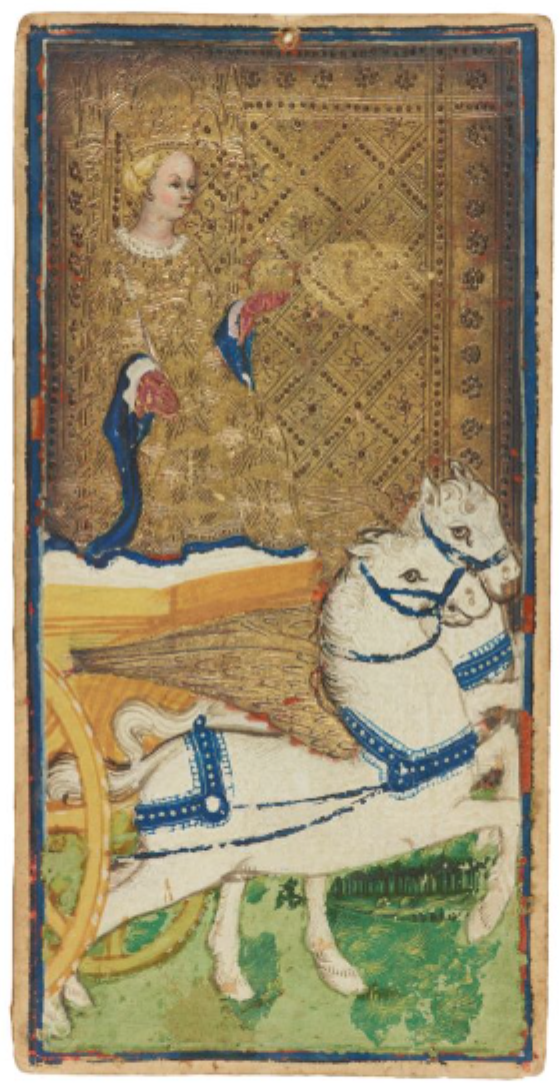
The Chariot card from the Visconti-Sforza
The Visconti-Sforza tarot was commissioned as a wedding gift for Bianca Maria Visconti, the daughter of a Duke, and Francesco Sforza, a military leader/mercenary. Of course this was a strategic marriage, orchestrated to increase the status of both families. Soooo yeah, one of the earliest tarot decks has its roots in hierarchy and imperialism.
Some tarot historians (starting with Gertrude Moakley) believe this original Chariot card shows Bianca Maria herself, but she seems to be taking on the role of Laura, the woman who inspired Petrarch’s famous poems I Trionfi. Mary Packard writes:
“As driver of the chariot, Laura displays multiple symbols of authority, including the golden crown on her head, the scepter carried in one hand, and the imperial globe held in the other. Enacting the Neoplatonic quest for immortality, Laura manifests as archetype for the hero. She must exert her will over the winged horses – one of which represents the Soul of Appetite and the other, the Soul of Will – as she guides the entire chariot/soul toward enlightenment.”
It’s difficult to see the scepter and globe in the above image as they’ve faded some from the originals, but they are visible in versions of the deck that have been restored.
I guess we need to talk about Plato a bit more. In Phaedrus Plato compares the soul to a Chariot with a driver and two winged horses, the same metaphor referenced by Packard above. A dark horse to represent the Soul of Appetite (or desire), the “lowest” part of the soul. A light horse to represent the Soul of Will (or Spirit). And the Charioteer represents the Soul of Reason, the “highest” aspect of the soul who directs the others. As we talked about last week, Plato’s work was trending during the Renaissance and does seem to have crept its way into the tarot.
It was 19th century occultist Levi who transformed the horses from earlier decks into sphinxes; the Waite-Smith tarot shows sphinxes as well. This was an attempt to highlight the supposed Egyptian origins of the tarot that early occultists proclaimed. It’s also interesting to me that the earliest cards showed a female Charioteer, some of the Marseille variations appeared gender nuetral (imho), but by the time Levi and Waite created their versions the Charioteer becomes male.
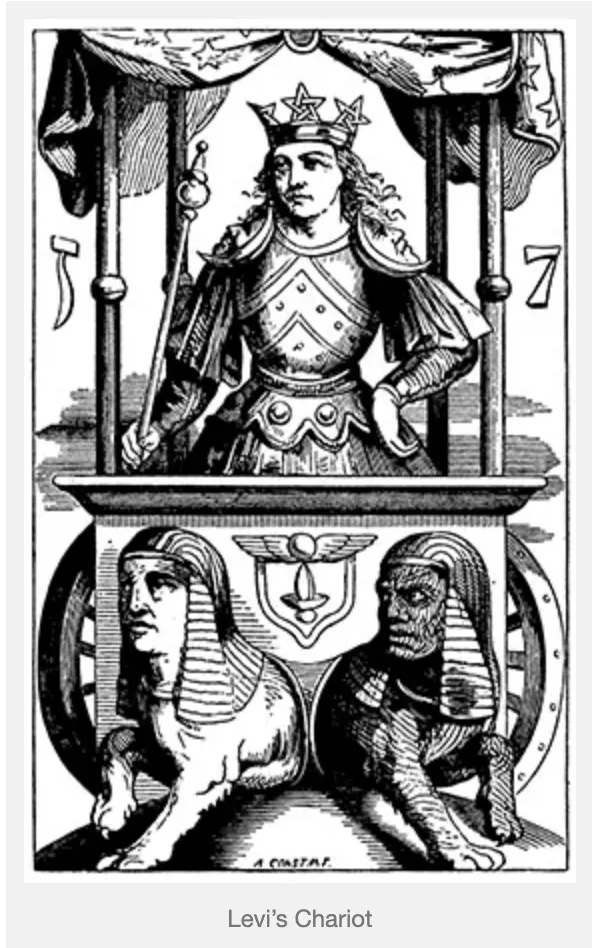
Image via robertmplacetarot.com
I’m currently reading Mystical Origins of the Tarot by Paul Huson which I bought because Rachel Pollack references it often in Tarot Wisdom. Most notably, Huson tracks the way the interpretations of cards evolved from the earliest occultists through Waite and the Golden Dawn. These interpretations don’t always line up with what we now know about the actual history of the card, because the occultists were not interested in (or even aware of) the Renaissance origin of the tarot and had their own fanciful theories about the cards.
Per Huson, Court de Gébelin described the Chariot as “Osiris triumphant.” Paul Christian continued this line of thinking, interpreting it as “the Chariot of Osiris, victory, a war chariot, an armed conqueror….the two sphinxes symbolize Good and Evil, one conquered, the other vanquished, both having become the servants of the Magus.”
In the Pictorial Key to the Tarot, Waite writes:
“He is above all things triumph in the mind. It is to be understood for this reason that (the Chariot) is concerned with a mystery of nature and not of the world of Grace, to which the charioteer could offer no answer. The planes of his conquest… are external and not within himself…the initiation he has passed in triumph is to be understood physically or rationally…if he came to the pillars of the temple of the High Priestess he could not open the scroll, nor if she questioned him could he answer.”
I think we see some of Waite’s ideas reflected in more modern interpretations, in many ways I think Rachel Pollack expands these thoughts in 78 Degrees of Wisdom. This was one of the first books I read on tarot and it has been instrumental in my understanding of this card. Rachel says:
“When we look at the cards sequentially we see 7 is only the victory of the first line of the Major Arcana. It crown’s that line’s process of maturation, but by necessity it cannot address the great areas of the unconscious and super-conscious. Seen this way the Chariot shows us the developed ego…the mature adult successful in life…able to control feelings, and above all, to direct the will.”
I can’t find the exact passage right now, but I believe it was also Rachel Pollack who pointed out that some people never move past the Chariot-level of development. Many commentators have compared the Chariot to Carl Jung’s concept of the persona – the curated ‘mask’ a person shows to the world. There is, of course, nothing wrong with developing a persona. In fact, it is essential to existing in this world. But in Rachel Pollack’s view of the three rows of the minor arcana, the second and third delve more into the nuances of the inner realms, as well as cosmological universal forces. Some venture there, some prefer the allure of stable identity and success represented by the Chariot.
Part Two: The Chariot & Me
Now that I’ve shared some historical context, I will divulge more about what the card means to me.
My intro to tarot was Learn the Tarot by Joan Bunning and there’s a specific angle she takes with the Chariot that has stuck with me all these years. Bunning uses the phrase “hard control” to describe this card. She views The Chariot as forming a pair with Strength, which is a “soft control.” There are other cards in the major arcana that are commonly seen as a pair (like the Magician/High Priestess, Emperor/Empress, Sun/Moon) but Chariot/Strength is not one you see all the time. I think this is a useful way to consider the cards, though.
At its worst, this “hard control” harkens back to some of the early influences of military conquest and hierarchy. Sometimes the Chariot is about making shit happen no matter what (or whom) gets trampled along the way. Whereas Strength is about patiently wrangling with something instead of forcing it into submission. As Bunning puts it, “there are many types of wins; the Chariot’s is of the win-lose type.”
Bunning also talks about will power as a key concept to this card. As someone who often feels scatterbrained and unfocused, this is an aspect of the Chariot that beckons me. I think about how much easier life would be if I was able to focus. If I could make decisions and move singularly towards them. If I had a concrete idea of who I was and what I wanted and moved pointedly in that direction.
As with any card, there’s a spectrum of potential (term borrowed from Arthur Rosengarten) in the Chariot. I try to avoid over-simplifying this as ‘positive and negative’ but there are ways that Chariot energy can be beneficial, and ways that it can be harmful. Chariot energy can inspire a healthy sense of identity and usher you forward to accomplish meaningful things. Or it can turn you into Ayn Rand.

The Waite-Smith is the deck I started out with, and while I’m not going to break down every symbol here I wanted to mention what stood out to me the most as I learned tarot. That is the black and white spinxes, and how they seem to be going in different directions. Beyond the Platonic interpretations mentioned above, it’s always spoke to me of the necessity of managing any number of conflicting factors. Like… your practicality establishes one direction, but your passion veers you off course. Somehow you as the Charioteer need to navigate all this paradox to chart a singular course.
In writing this post, I’ve taken on the dreaded task of revisiting some of my old writings (fun fact about me: I want to disappear into a black hole every time I re-read something I wrote). I still quite resonate with how I wrote about the Chariot for my Wild Unknown blog series back in 2014:
I like to think of the Major Arcana as three sets of seven cards (with the addition of the Fool). In this view, the Chariot is the last card in the first row. In some ways, this card reminds me of a young adult, someone who has certainly matured but may have a narrow view of their overall growth. The Chariot speaks to a dogged determination to go in a certain direction, but on the shadow side Chariot energy can sometimes become TOO pushy and forceful…
There are many cards that speak of ease and flow, but the Chariot shows a counterbalance to these concepts. The Chariot is about determination, hard work and grit. In a metaphoric sense, you are a charioteer and the chariot you drive is your life. You have a responsibility to assert your control over that chariot and to take ownership over the direction you are headed.
The Chariot draws your attention to you and your path. This is a common theme in the visual presentation of this card in various decks. This card asks you to stay in your lane, to be aware of what YOU are doing. A shadow side of this can be selfishness and inflexibility. But at its best, Chariot energy brings you in touch with your most powerful autonomy.
There’s still something appealing about all of this to me, especially this idea of having SOME ability to direct your own life. Sometimes the external world and my own goddamn brain are so chaotic that I feel like I’m just being pulled along on the ride.
And maybe I am. The actual sphere of control for most of us is pretty small (and obviously varies depending on our unique privileges or lack thereof). I acknowledge that. But the Chariot is a reminder that there are some ways you can take the reigns, if you chose to do so. It reminds me of a quote I came across many years ago but can’t find the exact source: “I want to walk through life, not be dragged through it.”
When I finished writing this section I took a break and opened Instagram (as one does). The top post in my feed was from Chani Nicholas and this line got me: “all systems of supremacy bank on us forgetting how powerful we are! May we reclaim our agency!” This perfectly encapsulates what I’m trying to say here, and it brings us full circle from the card’s origins in conquering, into a more modern take on the Chariot’s potential to recalibrate our autonomy.
When creating the concept for the Spacious Tarot, I attempted to convey how the energy of the Chariot feels to me instead of relying on traditional imagery. So we ended up with something pretty different from the Waite-Smith or any of the earlier decks for that matter.
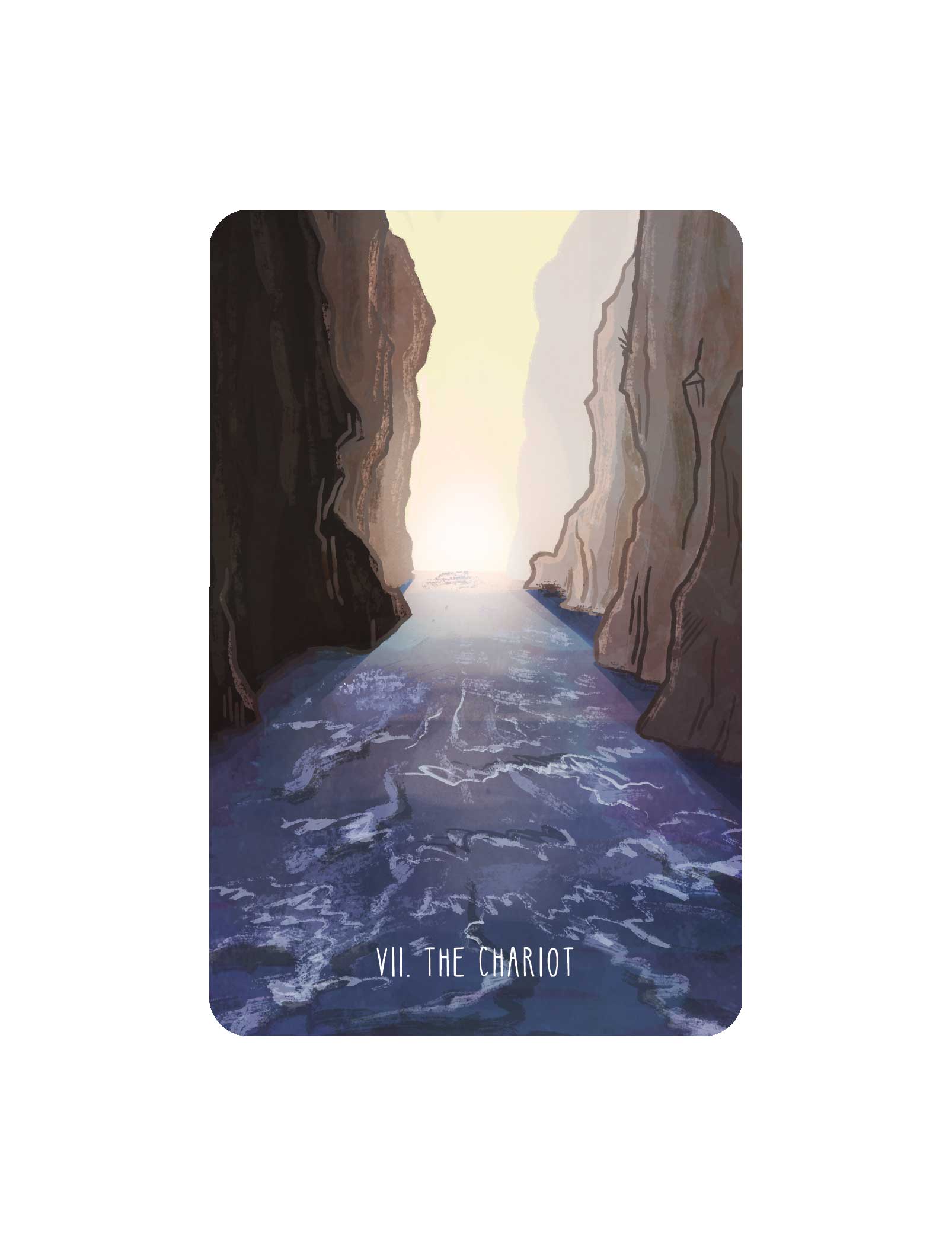
One time I was wading near the edge of the Colorado River and stepped in a little too far. The current grabbed me and I panicked for a moment because I could not fight against it. I managed to grab a tree branch and pull myself out before I got swept away, but I’ve never forgotten that sensation. It’s part of why this imagery came to me. I picture the determination it takes to press forward against a (metaphorical or literal) current and move towards the light on the horizon. And the power of something as simple as water to carve rocks and canyon walls.
This was more of a synchronicity than something intentional, but I like that we ended up with water in our version. The Chariot relates to Cancer in the astrological system used by the Golden Dawn. This has always been odd to me as I am a Cancer Sun and I see very little overlap in the zodiac sign and the tarot card. It’s one of the reasons I only toy with linking tarot to astrology and have never made it a pillar of my practice. Nonetheless, Cancer is a water sign and it pleases me that we have water in our depiction of the Chariot.
With the first person perspective we emphasized that the Chariot is about forward movement. I have a tendency to get moored in nostalgia and over analyzing the past. Sometimes that’s okay. But the Chariot echoes the expression “don’t look backwards, you’re not going that way.” ONWARD!
Part 3: The Year of the Chariot, 2023
I have the benefit of hindsight since I’m writing this closer to the end of 2023, but have been jotting down some notes for this post throughout the year.
Before we go further here, I want to tell you that I’m not going to be talking directly about the violence in Palestine in this post. I’m giving what I can to Doctors Without Borders and I echo what Chani Nicholas went on to say in the post referenced above: cease fire now. This horror intensified after I’d outlined much of this, and I believe it would be in poor taste to focus on it in the context of this post.
I wrote this sentence down at the beginning of 2023 when thinking about themes the Chariot might present this year: “identity, when to reaffirm vs when to soften out of it, moving beyond what your ego is comfy with.”
This has certainly been applicable for me this year. There’s parts of my identity I’ve been consciously trying to strengthen, like: I identify as a writer. A tarot practitioner. Solidifying that thru starting this Substack. Meanwhile, there are other parts of my identity I’ve loosened my grip on.
Some journaling prompts you could try for yourself: how has my identify shifted in 2023? What do I identify more with? What do I identify less with?
Earlier in the year I listened to an interview with Jarod K Anderson and he said something that connected some of the Chariot + 2023 themes for me:
“A lot of people who I feel like are not wrong, are calling for various kinds of revolution and deconstruction. And I don’t think that’s wrong. But I also think that if your thing is, say, industrialization of farming, and food production, and all of the consequences of it, I want to know more about how you feed everyone than how you destroy the industrialized farms. I just kind of feel like those insidious fingers of our cultural narratives, sneak in to even our well-meaning narratives of progress, because the destroyer is romanticized and the healer, and the grower, and the caregiver is not in so many of the dominant narratives.”
The bold part is what got me: the destroyer is romanticized. In fact, it reminded me of the origins of the Chariot, the Roman generals being celebrated for killing and imprisoning. That could be something to examine personally + collectively this year.
Who are the destroyers you’re romanticizing in your personal consciousness? And who/what are the destroyers we collectively romanticize? How can we direct our focus more towards solutions + healing? How can we keep shifting towards where we want to go instead of obsessing over the obstacles to that path?
A few months ago there was a sound trending on TikTok of Elyse Meyers saying “I don’t think there’s anything I couldn’t do at least half decently. I was born with the ‘how hard could it be’ gene, which is incredibly helpful and very delusional. It’s made me pretty lucky.”
This is total Chariot vibes, and as someone who was NOT born with this gene I want in on it. Since the Chariot is also about willpower, I suppose it’s fair to say I’ve been trying to will myself to develop this gene (moreso the helpful parts than the delusional parts). This harkens back to the ONWARD themes, the light on the horizon. How hard could it be to get there?
2023 has been a very difficult year for me personally, and the Chariot has been relevant in the way I’ve tried to just…keep going. Check my silly little emails. Go on my silly little mental health walks. Make incredibly simple to do lists just to feel like I’ve accomplished something. The Chariot isn’t always big and bold. Sometimes it’s just taking the next small action even when life seems completely overwhelming.
Well my friends, there’s always more to say but this seems like as good of a place to close things out as any. Thanks for takin’ a ride in the Chariot with me. I am sending you the very best wishes as we continue to move forward, forward, forward. Talk to you again soon.
Carrie
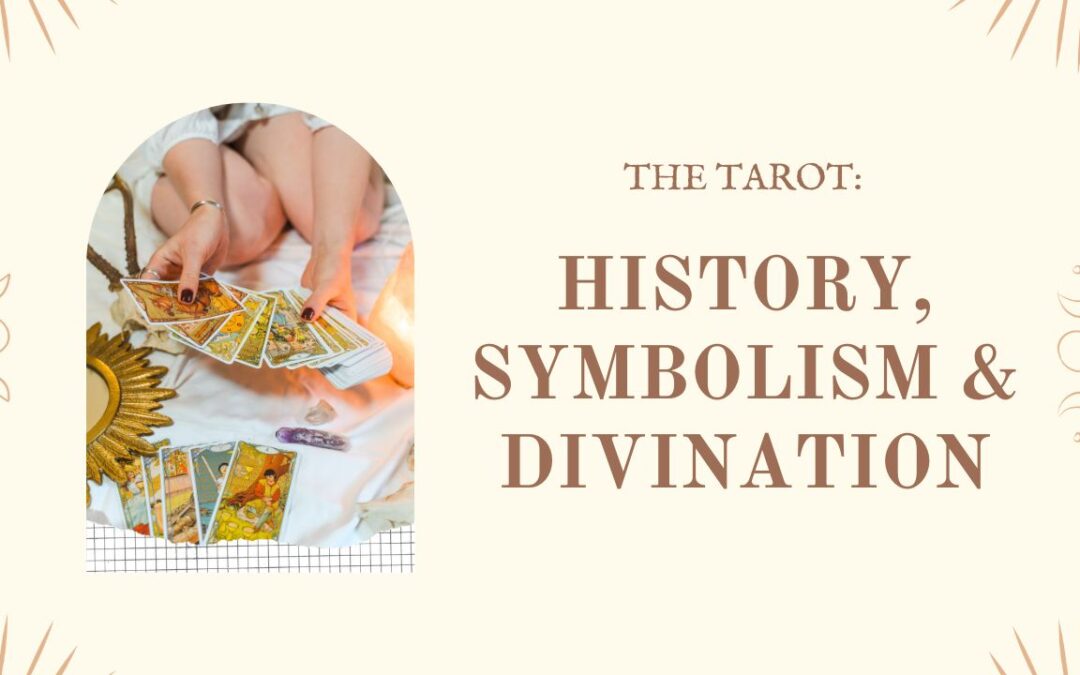
This recontextualized my understanding of tarot
Sometimes I finish a book and immediately start it again. That’s what happened with this one.
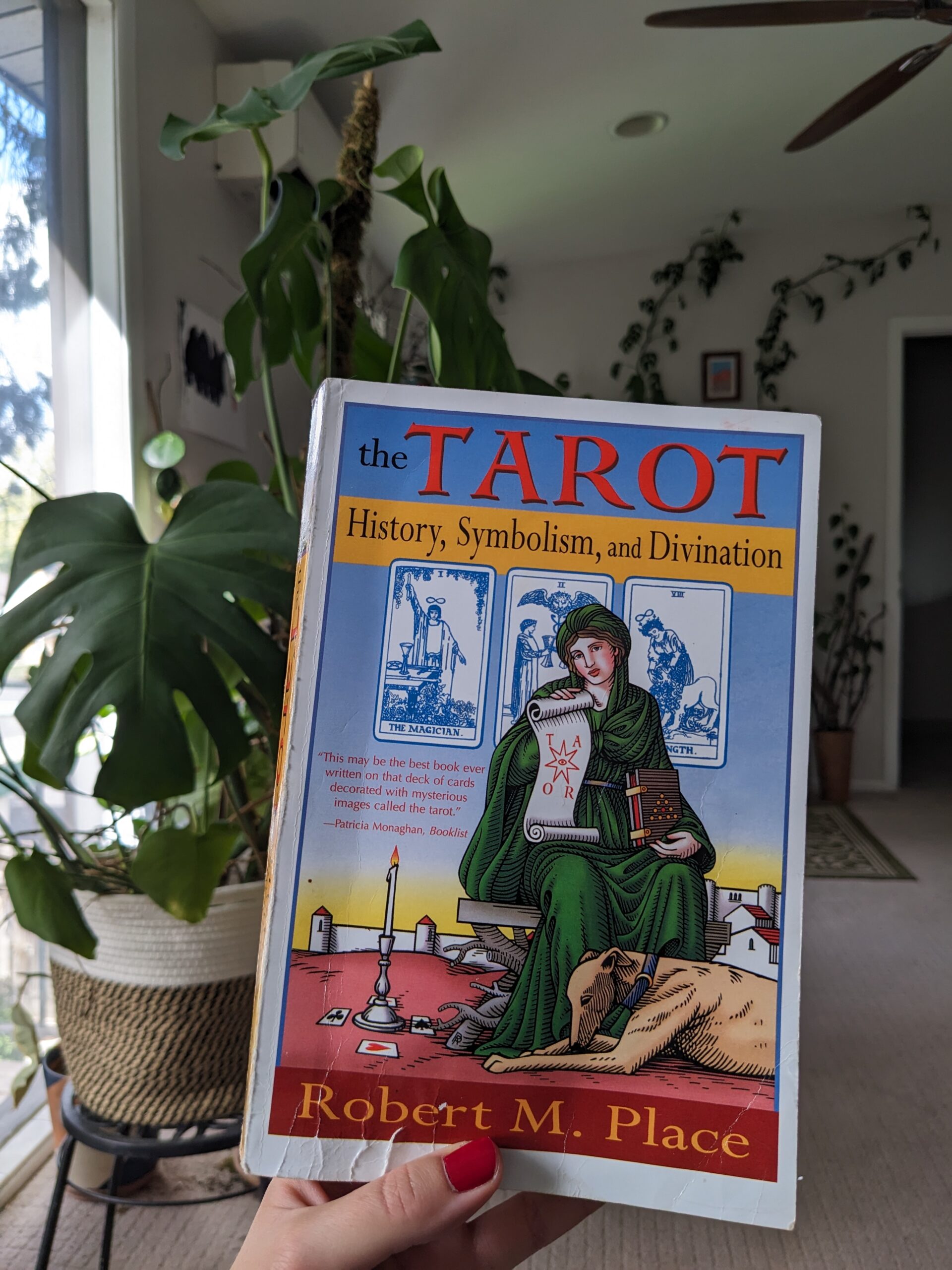
Before I read this, I thought: eh, I know enough about tarot history. I’m not an expert but I can hit on the key points (started as a game in Renaissance Italy, picked up by occultists, blah blah blah). Besides, it’s kind of a boring topic. I’d rather talk about tarot’s present, or tarot’s future.
Turns out that first of all, tarot history is far more fascinating than I thought. Like how the first High Priestess card may relate to a 13th century woman who inspired a heretical movement with the belief that female popes were poised to rise up in the Catholic church. Or how the first occultist to popularize tarot divination was almost denied publication by the royal censor, possibly due to sabotage by another occultist.
And secondly, smart people have said that studying history is the best way to have a better foundation in the present, and a more robust springboard for the future. Guess I have to admit they have a point.
So! Before we go further, a bit of context about this book. Published in 2005, author Robert M. Place draws heavily upon the work of tarot historians Ronald Decker and Michael Dummett (I haven’t read their book A Wicked Pack of Cards: Origins of the Occult Tarot but I know it is widely respected). But this is far from a regurgitation of existing research. With a respect to historical facts, Place comes into this work with the thesis that ‘tarot is like a door that opens onto the Western Mystical Tradition.’ The tone of the book is somewhat academic and no-nonsense, but it still approaches tarot as a tool with authentic mystical value.
The book begins with a punchy section on tarot history. I say punchy because it’s only 26 pages but covers a lot of ground. I’m talking, we start with the invention of paper in 2nd century China and go into the development of playing cards in China, the Islamic world and eventually into Europe. Renaissance Italy is when the deck really became tarot, with the addition of the ‘trump’ cards (ick, can’t type the word trump without wanting to throw up in my mouth a little).
Side note but I found this interesting: at some point Place points out that a lot of what we now know about tarot history was only really verified in the past ~40 years. As its now been ~18 years since this book was published, I’m not sure how much new info has surfaced. But for its time, at least, I think the history info presented here was meticulously researched.
A few things that stood out to me from this first chapter because they really did recontextualize my understanding of tarot: Place clarifies that the Visconti-Sforza cards are the oldest EXISTING tarot cards, but not the oldest KNOWN. These cards were hand painted for the rulers of Milan, likely in the 1450’s, and if you know a bit about tarot history you’ve probably heard of them. There are records that show older decks existed, but they have not survived that we know of. This was news to me because with my very basic understanding of tarot history I was under the impression the Visconti-Sforza did indeed represent the very first tarot decks.

Visconti-Sforza tarot cards, image via Wikipedia
A random thing that fascinated me about the Visconti-Sforza: The Tower, The Devil and the Three of Swords are missing. Well, maybe they are missing, maybe they didn’t even exist in these early decks, Place says there’s no way to know for sure which is the case. Either way I love this idea and as I shared on Threads I think someone could write a great historical fiction about what happened to these cards.
Place pays some attention to the Sola-Busca deck which is another one you might have heard of because it is an early example of more fully illustrated pip cards (vs most older decks that simply show suit tokens for the numbered cards). I knew about the Sola-Busca from Rachel Pollack’s wonderful book Tarot Wisdom and I also knew that it inspired some of Pixie’s illustrations for the Waite-Smith deck several hundred years later. Rachel includes side by side illustrations of both decks, but I was kinda like ‘meh, they don’t look THAT alike.’ I mean, some are very obvious like the Three of Swords. But until Place pointed out some of the more subtle similarities, I didn’t connect the extent of Pixie’s inspiration.
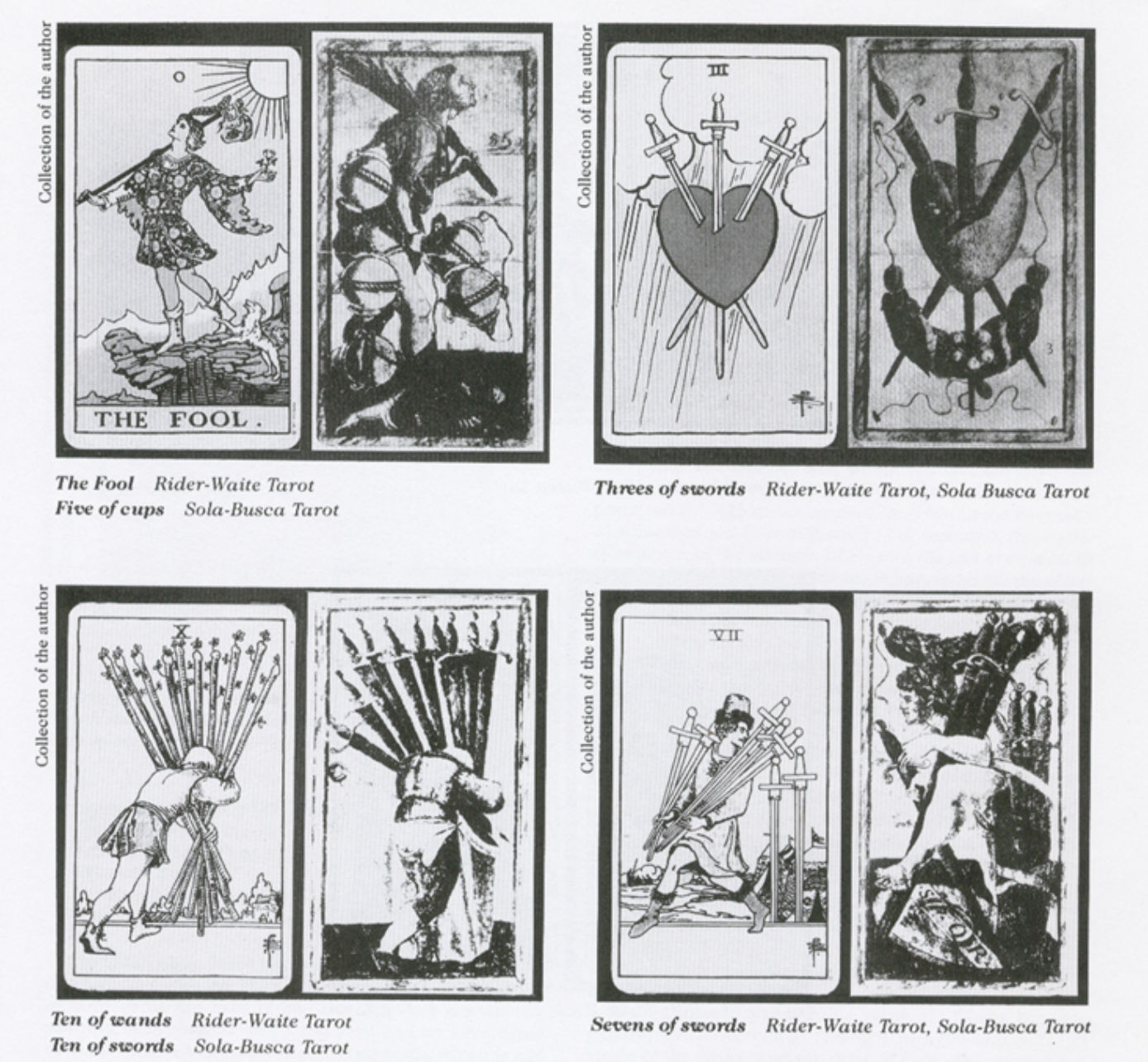
Photos from Stuart Kaplan’s ‘Encyclopedia of Tarot’
Now, with my previously basic understanding of tarot history I’d always believed the oft repeated statement that TAROT STARTED AS A GAME DURING THE RENAISSANCE, and wasn’t used for divination until the occultists got interested a couple hundred years later. But! Place says there is ‘conclusive’ evidence that regular playing cards were used for divination during the Renaissance, and although we may not have definitive proof, it is possible/likely that tarot cards were as well.
Now these are references that come from the 16th century, but Place shares a description of a party game, supposedly played during the Renaissance, where tarot trumps were distributed to guests and everyone else would describe why that card matched that individual. Sounds fun, should we bring this back?
In closing out this first chapter, Place points out that an effort to pinpoint the ‘first’ or ‘true’ tarot is futile. He describes it as a collective art, something that many people have had hands in developing. Very true and this is one thing I love so much about tarot. And the development is ongoing to this day, I say!
The next section of the book, The Mythical History of the Tarot, is where things get even more interesting. Place thoroughly details the tarot lore purported by occultists starting in the 1780s and all the way through the Golden Dawn and the creation of the Waite-Smith deck. I knew some of the basic stuff about Court de Gébelin and Etteilla and how they really started this whole shebang by claiming the tarot had origins in ancient Egypt.
Of course, most modern tarot readers know the supposed Egyptian origins are inaccurate. But I’m not sure most modern tarot readers know that many of the concepts you still work with today were originally put forward specifically by Etteilla in the 1700s. Like, I knew the dude was influential but he seems to be the first to do ALL of these things:
-
use the word cartomancy
-
connect the four suits to the four elements
-
publish a book on tarot divination
-
change the suit of coins to be pentacles, or magical talismans
-
link tarot to astrology
-
introduce the concept of reversed cards
Not bad for a guy who started out as a humble seed merchant. Fun fact: he’s also the one who was almost denied publication by the royal censor, rumor has it this was because of his rivalry with Court de Gébelin.
I won’t go into every interesting thing in this portion of the book because we’d be here all day and you can just like, read the book for that. But it is all quite interesting to see Place attempt to “separate the kernels from the chaff” when it comes to the ideas, hoodwinks and shenanigans of the early occultists.
As I mentioned earlier, this book is meticulously researched and largely concerned with facts. But Place still strongly holds that tarot is indeed a mystical tool. Some of the ideas presented by occultists may not be literally true, but still have symbolic resonance (others are flat out harmful bullshit, so we must be discerning). So here’s where we get into what seems to be the thesis of this book:
Tarot originally developed during the Renaissance. This was a time where many old mystical ideas were being rediscovered and reinterpreted. Some mystics of this time had a particular interest in fusing the teachings of Christianity with the teachings of Plato, in what is now known as Neoplatonism. Place describes several schools of thought which loosely fall under the Neoplatonist umbrella including hermeticism and alchemy, and lays out the case that these concepts were widespread during the Renaissance and it is not unlikely that their influence seeped into the creation of the earliest tarot decks. In Place’s opinion:
Tarot expresses a mystical Neoplatonic philosophy. Specifically, the tarot trumps are an allegory of the soul’s journey to immortality or enlightenment. This allegory is expressed in three groups of seven cards. Symbolically, the number seven is associated with the Neoplatonic ladder of seven planets that forms a stairway by which the soul ascends to the spiritual realm…
The three groups of seven cards allow the sevenfold ladder to be repeated on three levels of increasing spiritual awareness. These three levels are related to Plato’s theory of the three aspects of the human soul.
The tarot also makes use of the triumphant parade as an organizing principle and a metaphor for the triumph of the soul. Tarot is one of numerous works of art from the Renaissance that make use of the same metaphor to express a mystical story…the philosophy expressed in tarot has its roots in ancient mysticism.
Right now I’m trying to stop myself from going on a tangent about the three rows of seven cards thing. This is a concept I’ve been familiar with since my early days as a tarot reader, and it is another thing I was introduced to by Rachel Pollack. It was only through reading this book by Place that I realized some version of this theory has been around since the 1700s, originally introduced by de Gébelin’s colleague de Mellet. It has evolved and been reimagined many times since then, but is still a popular framework for considering the cards today.
Returning to the idea of the ‘triumphant parade’: credit must be given to tarot scholar Gertrude Moakley, who made major breakthroughs in tarot history. While not all of her theories turned out to be correct, she published several bombshell pieces on tarot history during the 1950s and 60s. IT IS A CRIME THAT I HAD NOT HEARD OF HER BEFORE ROBERT M PLACE MENTIONED HER IN THIS BOOK.

Gertrude Moakley, image via tarot-heritage.com
Moakley was the first to suggest that the tarot’s trumps could have originally been related to I Trionfi, the famous 14th century poems by Petrarch which were very popular at the time tarot emerged. The general consensus now is that the cards do not line up perfectly with the poem, but Place believes that nonetheless tarot is part of the same tradition as I Trionfi, which also has heavy Platonic themes.
Moakley also kickstarted the movement to give Pamela Colman Smith credit for her work, and it was Moakley who started referring to the deck as “Waite-Smith” (with it previously being referred to most commonly as “Rider Waite,” Rider being the publisher and Waite being, of course, Arthur Edward Waite).
In the next chapter Place goes into each major arcana card and more thoroughly explores what he believes to be the earliest influences for them. This is where we get the anecdote about the High Priestess (known as the Papesse in these early decks) that I alluded to earlier. Place writes:
“In the 12th century the monk Joachim of Flora had an epiphany… (of a) New Age, in which the Church would be dissolved and individuals would communicate directly with God. His vision inspired the Guglielmites. Their founder, the visionary heretic Gugliema was believed to be an incarnation of the Holy Spirit. Gugliema predicted that in 1300 the New Age would begin and there would be a line of female popes. Her followers elected Sister Manfreda, a relative of the Visconti family, as the first papesse. The inquisition destroyed the sect and although when they found the new papesse she was already dead, they burned her body at the stake. Moakley believes the Visconti-Sforza Papesse card is a portrait of Sister Manfreda.”
Now! Let us not commit the fashionable stupidity of only focusing on the major arcana and not the minors. Place explores the history of the four suits all the way back to the Mamluk decks of the 13th century. Place believes it is likely that the four suits of the Mamluk decks represent aspects of the life of a Mamluk noble (as with the later Italian decks, these decks were created for the wealthy). Place speculates on how the correlations to the four suits may have evolved once the cards reached Europe, and also touches on the various correlations occultists have proposed.
This is as good of a place as any to talk about the terms major arcana and minor arcana. This nomenclature comes to us courtesy of 19th century occultist Paul Christian. This guy was sketchy overall, to be honest. Place notes that the authors of A Wicked Pack of Cards describe him as “that rare thing among those encountered in these pages, a wholehearted charlatan.” He forged evidence connecting tarot to ancient Egypt. Not cool. BUT! He gave us something way better than ‘pips and trumps’ to call deck components and I’m really grateful for that.
Then this book blew my frickin’ mind when it comes to my boy Carl Jung. I had a passing knowledge of Jungian psychology when I first got into tarot. All on my own, I connected the four suits to Jung’s four functions. I was feeling pretty proud of myself until I realized I was FAR from the first person to do this – Jung has been a touchstone to tarot readers since at least the 1960s if not earlier.
So it’s not that Place mentioned Jung’s psychological functions that blew my mind, it’s the way he’s done it. I’ve always seen the correlations as Wands to Intuition, Swords to Thinking, Cups to Feeling, and Pentacles to Sensation. But Robert M Place switches Cups and Wands, attributing Cups to Intuition and Wands to Feeling. At first I was like ‘nah nope no’ but he makes an interesting case for this. According to Place, Jung’s feeling function is commonly misunderstood. This function is not about emotions. It is ‘a decision-making function that determines if something is good or bad and motivates one to action, symbolized by fire.’ I’m not sure I’m converted but I will certainly be thinking more about this.
Sidenote: last year I did a presentation at a tarot conference about the four suits and I talked a lot about Jung’s functions. Maybe someday I’ll record that for YouTube or something. If you’ve read this far and would have an interest in that let me know lol.
Well, well, well. The time has come to talk a little about none other than Arthur Edward Waite.
In some tarot circles it’s become trendy to hate on Waite. And sure, he isn’t above critique. His deck, as influential as it is, isn’t the end all be all. As was stated early, tarot is a collective art, always evolving. Waite is just one of many folks who have had a hand in the development of this collective art, but he really did some important things.
First of all, Waite is sometimes lumped in with all the other early occultists. But he would have hated this, I think. Waite considered himself a scholar and a mystic moreso than an occultist, and he went to great lengths to correct misinformation disseminated by his predecessors. The whole section about Waite’s involvement in the Golden Dawn is fascinating but I won’t regurgitate the whole thing here because again you can just read the book!
I do want to mention a lovely anecdote about Pamela Colman Smith aka Pixie aka the artist behind Waite’s tarot. Place describes her as part of the symbolist art movement and says that while she was illustrating, she would listen to music, go into a sort of trance state, and paint what she saw: “for example, while listening to Beethoven she painted a majestic queen in flowing robes standing on the sea carrying a small ball-like moon in her hands.” I’m not sure this is the piece described but it is a beautiful example of her work either way.
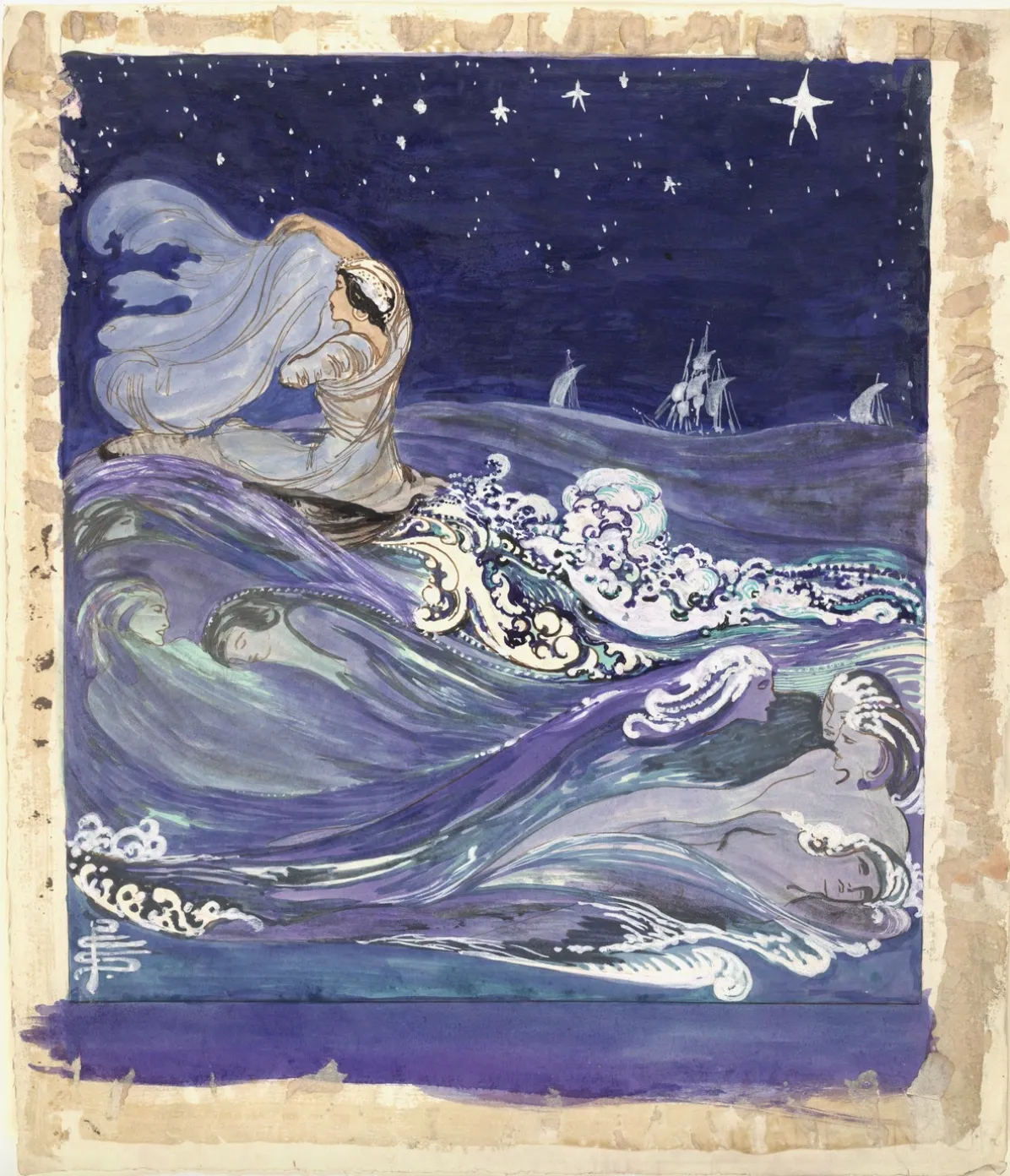
undated watercolor by Pamela Colman Smith
Another fact I learned about the Waite-Smith deck from this book: the entire freakin’ thing seems to have been created in ONLY SIX MONTHS. This is truly…wow. I mean, it took Annie and I three years to create the Spacious Tarot but okay.
Pixie famously wrote to a friend that she “finished a big job for very little cash” and stated she’d completed 80 illustrations for the project. Most people believe the extras were title cards, but this is another thing I mentioned on Threads: what if she created two secret tarot cards that somehow never made it into the deck? Seems unlikely but it’s a fun idea.
The next portion of Place’s book goes through each card in the Waite-Smith individually which to be honest I found kind of unnecessary as many cards get only one or two sentences, but there was some interesting info here.
The final chapter is devoted to the art of actually reading the cards. Place has some very particular methods which I haven’t tried and not sure if I will but I can respect them. He’s pays a lot of attention to directions in his three card spreads, explaining how the way the figures face impacts the ‘flow of energy’ in a reading. If you’re into more systematic methods of interpretation this could be fruitful to try out.
However, despite favoring what to me seems like a more analytic method of reading the cards, Place also highlights the role of intuition. At one point he even says that when you lay out the cards you should:
Interpret (tarot) as you would a dream or a story. At this point, one should forget everything one has learned about the meaning of the cards. Simply look at the layout. Often this causes a momentary panic when one realizes that one does not know what the cards mean. I often feel this myself. This is good, it is a sign that the ego is letting go. Take a deep breath, relax, and simply look at the cards. With patience, the cards will start to make sense in their own way.
Yes! This basically looks like something I would write. Hard agree. And this, my friends, is why I get annoyed at the age old debate of “intuitive vs analytical” tarot readers. Like…we are almost all both??? They can coexist??? I’m very tired of that debate popping up in the tarot community, but I’ve accepted it is something that always rears its ugly head no matter how many times it is addressed.
Well my friends, I need to wrap this up somehow. So what is my conclusion on the book Tarot: History, Symbolism and Divination by Robert M Place?
It is a very good book. I learned a lot and in many ways it really did recontextualize my understanding of tarot. I’m not sure I’m completely sold on Place’s thesis about tarot and Neoplatonism, but I do find it interesting. I think this would appeal most to those of you who want to learn more about tarot history. I don’t think you need to be an expert on tarot history to read the cards, but if you are a tarot nerd as I clearly am you’ll likely find it a compelling read.
So…yeah! That’s my review, I guess. Or at least a bit of a chaotic presentation of my thoughts on this book. A personal note as we wrap up: I haven’t written a long-form piece like this in a while. I miss it, but I’m out of practice. I very much appreciate you reading if you’ve stuck around this far.
As you may or may not have noticed, I’m publishing this on Substack. This is something I’m experimenting with. A lot has changed in the nine years since I started out as a professional tarot internet person. Back then, the norm was that blogging/social media/other content was something you did for free to generate interest in your readings or paid offerings. Now it is possible to get paid for ~creating content~ which I’m not doing yet, but I am interested in this as an option for the future, which is why I’m trying out Substack. If you were already on my mailing list, I’ve imported you here as a FREE subscriber. I hope that’s okay but you can unsubscribe if not!
I love creating and writing about tarot, but I’ve been really inconsistent in my output the past few years because…well…it doesn’t make me money, and because of capitalism, I have to focus more energy on stuff that does. Boo. For now I’m keeping my Substack free to see if I can even manage to stick with it, but that might change in the future. I dunno. Just letting you know for full disclosure, I guess!
One last note on the personal business side of things: my website is still carriemallon.com and eventually I will post Substack pieces onto the blog over there as well. But at the moment I am in a terrible tech nightmare with WordPress where I am unable to update anything on my site. Fingers crossed I can resolve that shortly…
Okay, I’m really done now. I very much appreciate you reading and sharing this new space with me. I hope you found something interesting here and I look forward to connecting with you again soon.
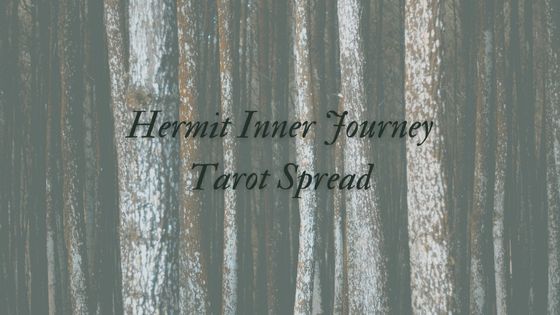
Hermit Inner Journey Tarot Spread
Hello friend,
I hope you are finding many abundant and delightful autumn experiences, if indeed it is autumn where you are. October is one of my favorite months of the year. I’ve been living my best autumn life by taking many long walks, drinking pumpkin beer on the porch, watching Over the Garden Wall, and of course doing tarot things.

It seems like I’ve been very quiet on the internet these days, but I’m lurking around here and there. I’m semi-back on Instagram and occasionally share to stories on my personal account.
But mostly, my focus is on the decks these days. Annie & I launched the Expansion Pack for the Spacious Tarot a couple of months ago so that’s been a whirlwind! I made a video last month talking candidly about the challenges we encountered on this journey.
I also recently shared a free mini-course on how to use the Expansion Pack and I’m slowly adding that series to our blog if you’re interested.

Oh my goodness, every time I look at our cards I feel feelings. They are so beautiful! Wow. How amazing to get to do this with Annie and get to share the cards with some of you. It’s really incredible.
The intensity of launching our second deck has settled down some. And Annie is now on maternity leave as just last week she gave birth to a beautiful baby boy. I’m still doing many deck related things, but I also now find myself with a little more SPACE to expand my focus. So now I’m asking myself: what do I want to focus on next? I have a GIANT to do list, but how do I proceed with it?
One of the things I’m considering taking on is doing National Novel Writing Month again. If you haven’t heard of this, it happens every November and I’ve participated a handful of times. I even wrote a blog series about how to use tarot for NaNoWriMo about a million years ago (okay seven years ago, but still).
So it was perfect timing when I found out my friend Heather Demetrios is teaching a Tarot for Writers workshop later this month (if you register, use code CARRIE and you’ll get 10% off!). Heather also crafted a Hermit Inner Journey tarot spread which you can use for your characters if you’re also a writer. Or, you can do the spread for yourself. I’m going to share the spread with you in a moment.
First, I want to gush a little about Heather. She’s the author of many books, including Little Universes which I absolutely adore. I read this book when it came out a couple years ago and as synchronicity would have it, I was in the middle of a re-read when Heather told me about her upcoming workshop.
I obviously love using tarot for writing, so I’d naturally be intrigued by a Tarot for Writers workshop. But I’m EXTRA excited to endorse this because I adore Heather as a human being and as an author. I also love that she’s created tiered pricing for this so it’s really accessible (plus, again, you’ll get 10% off with code CARRIE).
I am certain Heather will share absolute gems of wisdom during this event, AND she has the credentials to back it up. Her official bio follows:
“Heather Demetrios is a critically acclaimed author, writing coach, and certified meditation teacher based in Saint Paul, Minnesota. Her publishers include Simon & Schuster, Macmillan, and HarperCollins.
She has an MFA in Writing from Vermont College of Fine Arts and is a recipient of the PEN America Discovery Award for her debut novel, Something Real. Her novels include Little Universes, I’ll Meet You There, Bad Romance, as well as the Dark Caravan fantasy series. Her non-fiction includes the Junior Library Guild Gold Standard Selection Code Name Badass: The True Story of Virginia Hall, and she is the editor of Dear Heartbreak: YA Authors and Teens on the Dark Side of Love.
Her honors include books that have been named Bank Street Best Children’s Books, YALSA Best Fiction For Young Adults selections, a Goodreads Choice Nominee, a Kirkus Best Book, and a Barnes and Noble Best Book. Her work has appeared in LA Review of Books, Bustle, School Library Journal, and other fine outlets.
Heather works with writers on integrating mindfulness into their writing practice, process, and life. In addition to being a meditation teacher and Zen Buddhist in the Soto tradition, she holds certificates in Trauma Sensitive Mindfulness and Integrative Somatic Parts (IFS) Work.”
Tarot for Writers is happening live via zoom Wednesday October 26 from 7-9pm EST, with a recording available. Pricing starts at only $35 and you’ll receive a 10% discount with code CARRIE.
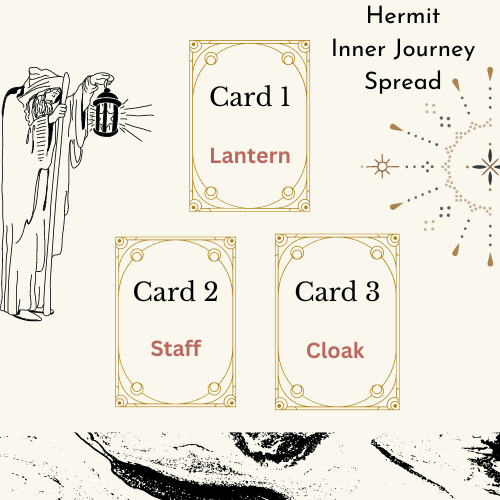
As the spread theme centers on the Hermit, Heather suggests finding this card in the deck and setting it aside as you begin the reading. In this way, the Hermit serves as a guiding energy for the cards you draw (I’m partial to Hermit themed spreads and even designed my own a couple years ago).
As you shuffle, Heather suggests asking “what do I need for my inner journey right now?” Or, of course, “what does my character need for their inner journey?”
Excerpted from Heather’s blog, the positions are as follows:
Lantern: This card represents what energy / forces / resources will be lighting your path as you go inward.
Staff: This card represents the grounding elements and forces in your life that will help you stay on your feet as you traverse this rocky terrain.
Cloak: This card represents the things in your life that will support, protect, and warm you during this journey.
I’ll share some insights I got when doing this spread for myself because…PHEW!
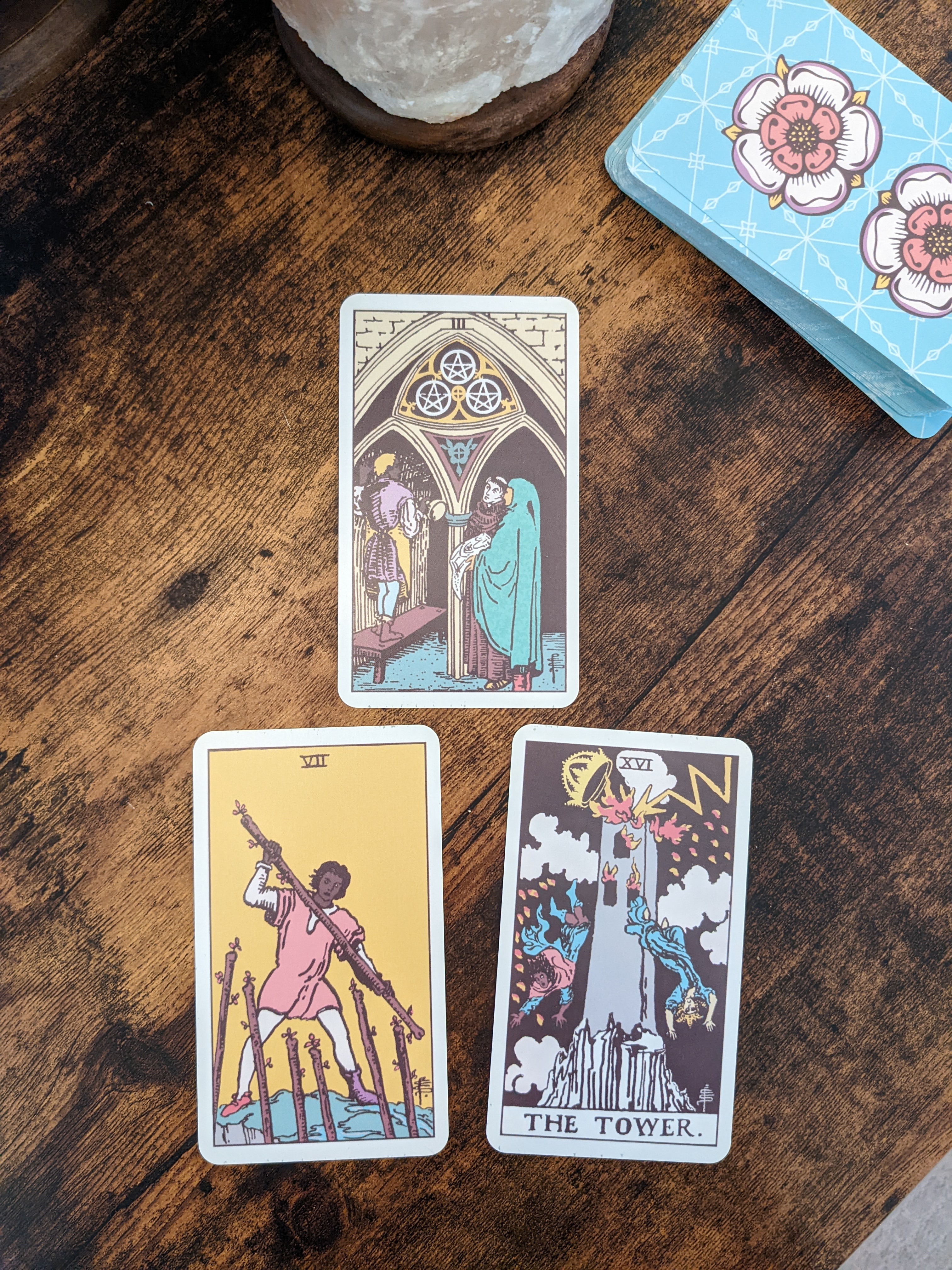
I’m using the Pastel Smith-Waite tarot.
Lantern: Three of Pentacles
Staff: Seven of Wands
Cloak: The Tower
My lantern is the Three of Pentacles. This card is particularly on the nose, as a key theme here is collaboration. And that is certainly a major theme in my life right now. Annie and I are always collaborative, but recently we dedicated some extra time and attention to prepare the business for her to step away and be with her little one. There’s even some meta-commentary here on the fact that by sharing this spread, I’m collaborating with Heather and her creative vision. Besides these factors of my work life, I’m also in the midst of a home project which has required collaborating with neighbors and professionals.
It’s lovely to me that the value of drawing upon others’ knowledge and skills, has arisen in this spread centered around the inner journey. It is truly a gift to know that I have support, that I don’t have to do everything alone. If I DIDN’T have skillful collaborators, I would not have any energy to give to my inner work. Trusting other people to carry some of the load means I can feel safe turning within and being more hermit-y when I need to.
My staff is the Seven of Wands and I actually laughed out loud when I drew this card. I mentioned earlier that I have a giant to-do list. Even as I’ve been writing this post, I’ve been interrupted no less than five times by ‘urgent’ tasks popping up. I quite literally feel like the figure on this card, trying somewhat frantically to keep up with every wand headed my way.
Initially it seems like a strange card to see in this position, but on a deep level it resonates. Heather says this card represents “grounding elements…and forces that will help you stay on your feet.” And I do acknowledge that what I need right now is to be spry to stay on my feet. Instead of being like “oh wah, so many wands, they are going to knock me down, boo hoo,” I need to be in this energy of “I GOT THIS! HERE I GO! BRING IT ON, WANDS!” Because the fact is everything that is currently on my to-do list got there because I said yes to it.
And going back to the message of the first card, I need to discern between what I need to step up and do myself, and what I can seek assistance with.
Another powerful message I’m getting from the Seven of Wands here: I have a tendency to push off tasks that when I finally end up doing them take like…ten minutes. Instead of just bursting out like the figure on this card and handling it, I can actually waste a TON of energy by not handling things. Weirdly, sometimes avoiding things is actually more energetically draining than just knocking them out. Even though this spread is centered on the inner journey, this is another reminder that my inner + outer world are inextricably linked. Paradoxically, sometimes it is by engaging with tasks in the outer world that I find transformation in my inner world.
So that’s my key message here: in order to be grounded, I need to just knock things out. If I’m saying yes to something, then say YES to it and blast through it. This is actually…exactly what I needed to hear right now, to be honest.
Now I have the Tower as my cloak. HA! Oh, the Tower. Me and this card go way back. It’s actually one of my favorite cards, even though it can at times be difficult. Here’s what I’m getting with this card in this spread: the thing that will support and protect me is knowing that upheaval is truly a constant in life. That doesn’t mean I don’t deserve peace. But I do have a tendency to avoid doing certain things because I’m waiting for things to “calm down” before I proceed.
In this way, the Tower and the Seven of Wands bring a similar message: life is chaotic. And that’s okay. There’s tremendous power in accepting chaos. In fact, sometimes I wonder if by resisting chaos I actually draw more of it in. Maybe by embracing the cloak of the Tower I can work WITH the chaos, let it flow through me. Because chaotic energy and creative energy are inextricably linked.
Thank you to Heather for sharing this spread. Doing it for myself it did not bring up what I expected, but I feel it brought up exactly what I needed. I can’t wait to use this spread to get to know the characters in my next writing project! If you want to learn many more ways to use tarot in your writing, Heather’s Tarot for Writers is bound to be helpful. And one last time: you’ll get 10% discount with code CARRIE.
Thank you for being here and I hope to be in touch again soon.
Begin or deepen your tarot studies with
Foundational Tarot, my free video course!
Join the email list for instant access.

Comparing my fave versions of the Waite-Smith tarot
Just a lil’ flip through of my two favorite versions of this classic tarot deck 🙂
Begin or deepen your tarot studies with
Foundational Tarot, my free video course!
Join the email list for instant access.
We need to talk about ‘The Tarot Handbook’ + tarot meditation for anxiety
Heya!
I’ve been going through a lot this year but I have posted a few videos to YouTube that never made it to my blog. So let’s round up a couple here.
First up, we need to talk about ‘The Tarot Handbook’ by Angeles Arrien. This book is the genesis of many tarot concepts we now take for granted (such as tarot birth cards) and I don’t think it gets enough credit. So let’s talk about it!
And in this next video I share a tarot-infused visualization for anxiety. This has helped me quite a lot this year. I also share some personal updates.
Begin or deepen your tarot studies with
Foundational Tarot, my free video course!
Join the email list for instant access.
Carrie Mallon
Header art from The Spacious Tarot illustrated by Annie Ruygt
All site content © Carrie Mallon LLC 2014-2019
Sign up for weekly updates


 I'm a tarot reader and mentor.
I'm a tarot reader and mentor. 